Archive for the ‘Wildlife’ Category
Saturday, August 17th, 2013
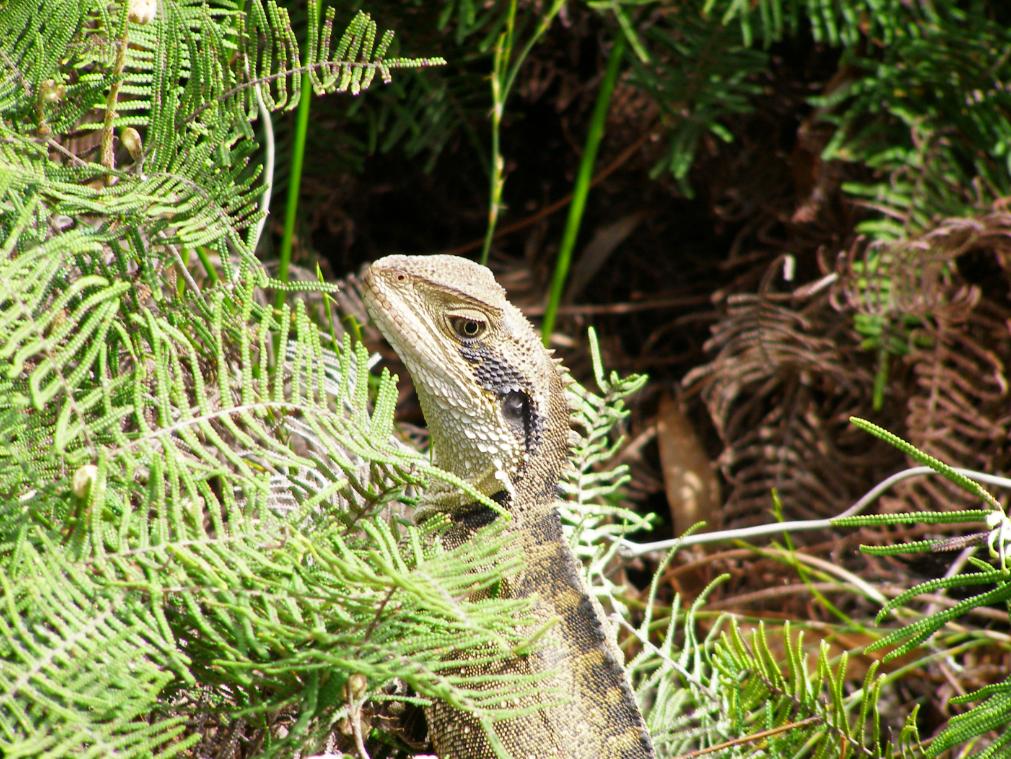 Eastern Water Dragon
(Physignathus lesueurii)
Taken for the benefit of the photograph, not the dragon
Photo by Editor in Blue Mountains, Australia, 20061112, photo © under ^Creative Commons]
Click image to enlarge Eastern Water Dragon
(Physignathus lesueurii)
Taken for the benefit of the photograph, not the dragon
Photo by Editor in Blue Mountains, Australia, 20061112, photo © under ^Creative Commons]
Click image to enlarge
.
Wildlife photography is not about humanising wildlife for entertainment. It ought to be about awareness, wonder and respect for wildlife and their habitat.
Zoology may be about technical understanding of the structure and classification of the animal kingdom, but since Darwin we have realised that animals are so much more complex creatures of behaviour and integral to ecology than just being taxidermied museum specimens for public display.
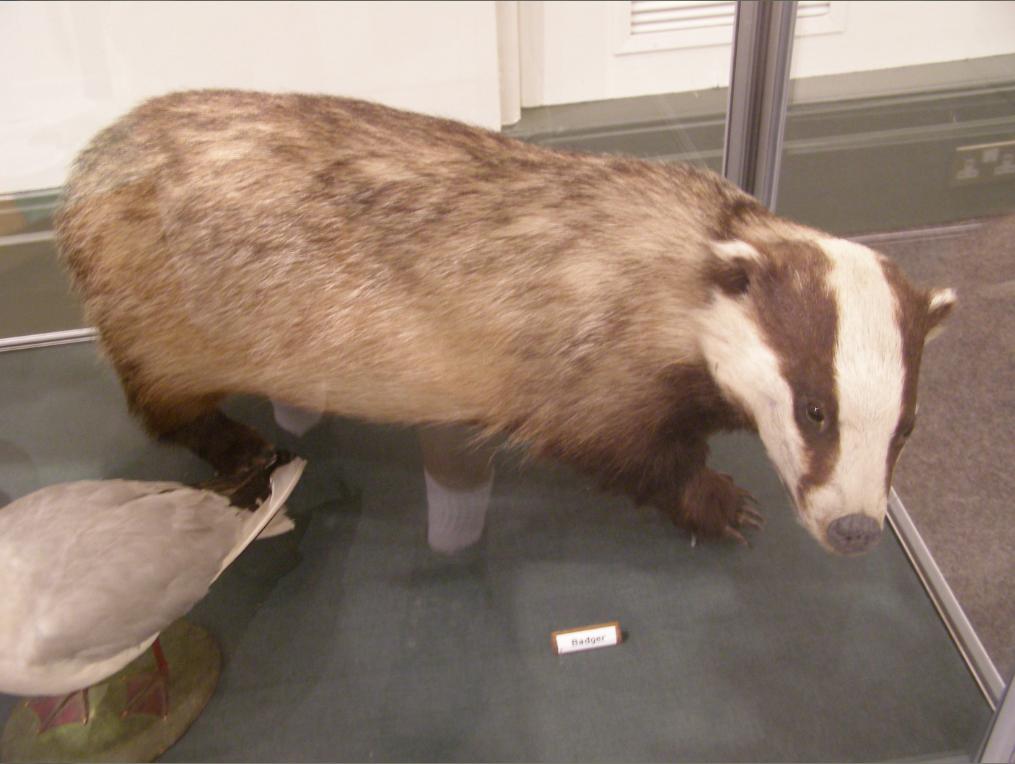
Zoos are just an extension of museums for the benefit of public entertainment. But they do not respect wildlife in their habitat.
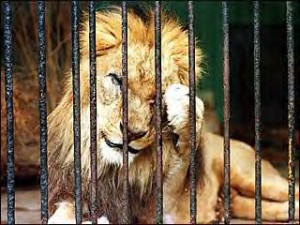 [Source: ^http://katialglobal2viceduau.global2.vic.edu.au/personal-learning/]
[Source: ^http://katialglobal2viceduau.global2.vic.edu.au/personal-learning/]
.
In their habitat and ecological context, photographed wildlife may be better appreciated and valued for their integral role in Nature. But at a respectful distance.
.
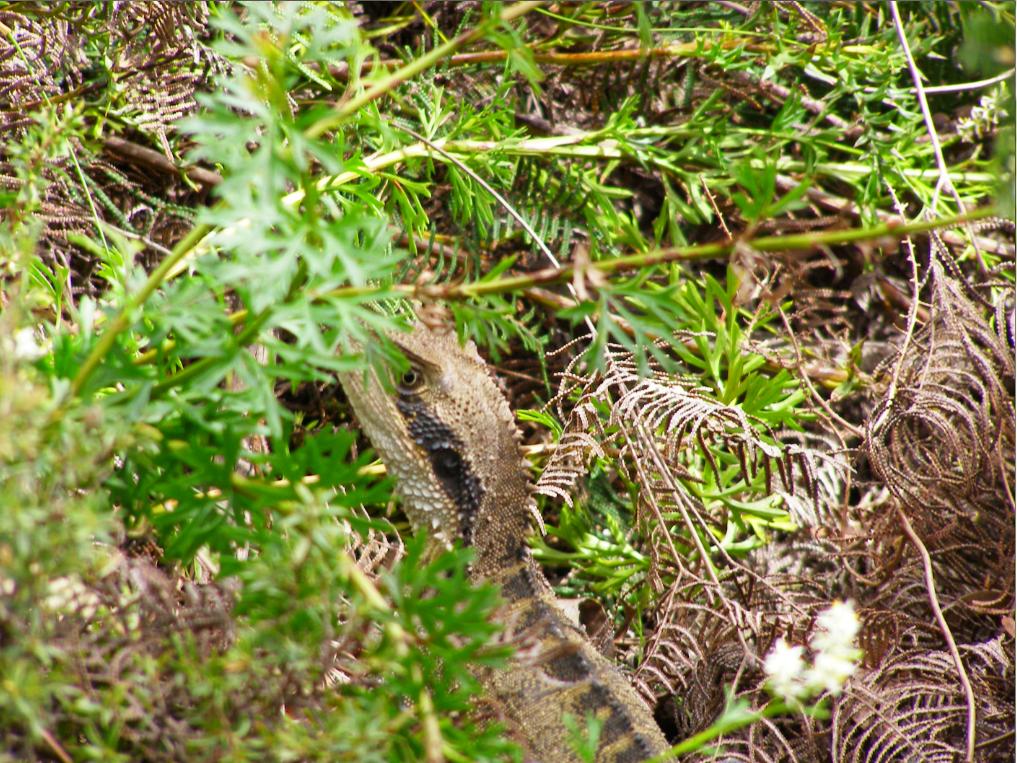 Not for the camera, but naturally obscured in its habitat
A more interpretative photo, but still too close.
Photo by Editor 20061112, photo © under ^Creative Commons] Not for the camera, but naturally obscured in its habitat
A more interpretative photo, but still too close.
Photo by Editor 20061112, photo © under ^Creative Commons]
.
“The two basic processes of education are knowing and valuing”
~ Robert J. Havighurst (1900-1991).
.
.
.
Empathy for Other Species is the Key to Ethical Wildlife Photography
.
[Source: “Empathy for Other Species is the Key to Ethical Wildlife Photography”, by Jim Robertson, ^http://www.wildwatch.org/Binocular/bino01/empathy.html]
.
<< A deep admiration for Nature has led many to another level of appreciation–the craft of wildlife photography.
Unfortunately, not all who photograph wildlife do so out of caring and with respect for our fellow beings. In fact, the behavior of many photographers, both amateur and professional, can only be described as disrespectful, disruptive and sometimes dangerous to the animals they are photographing.
For example, every spring in Yellowstone you are sure to see a large group of photographers standing around–or even sitting on lawn chairs–talking loudly right outside some poor badger’s birthing den, waiting for the family to emerge. Though these folks may think nothing of the clamor of a rowdy bar or ball game, how would they like to live next door to that bar or ball field, or wake up to the racket of an expectant crowd of photojournalists right outside their bedroom window?
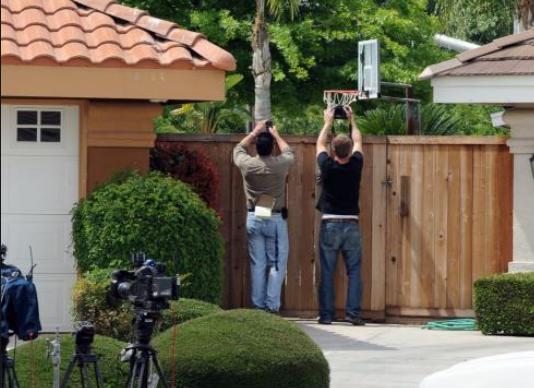
In response to this kind of ill-behavior, which invariably results in the harassment or endangerment of wildlife, informal guidelines have been established to spell out just how close, in yards or feet, one should get to an individual animal, depending on that species’ tolerance zone.
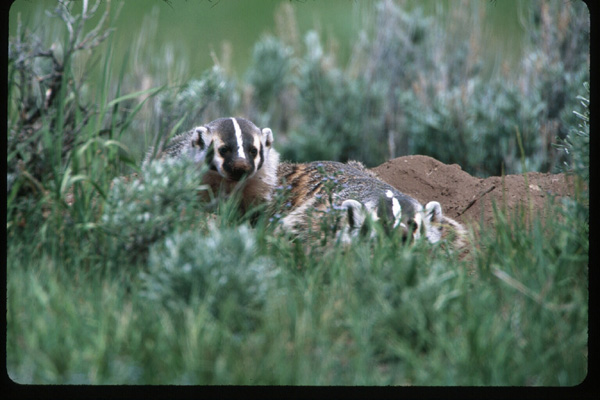 Badger Den
This mother and young badger were photographed across the road from their den using a 600mm telephoto lens and a 2X multiplier
Photo © Jim Robertson
^http://www.wildwatch.org/Binocular/bino01/empathy.html] Badger Den
This mother and young badger were photographed across the road from their den using a 600mm telephoto lens and a 2X multiplier
Photo © Jim Robertson
^http://www.wildwatch.org/Binocular/bino01/empathy.html]
.
But rather than memorizing numbers and gauging distances, perhaps it would be easier for photographers and wildlife observers to apply The Golden Rule in each and every situation.
However, instead of the old, oversimplified rule, “Do unto others as you would have them do unto you,” why not adopt a revised golden rule that takes into account the differences between ourselves and other species? Maybe something like, “Do unto others as you think they would have you do unto them.” In other words, try to envision what the animals’ needs and self interests are and take into consideration how their lives in the wild are different from our own.
Empathy, the intellectual or emotional identification with another — or the ability to relate to others — is essential for maintaining ethical standards when photographing wildlife.
Last spring I watched from a distance as the annual gathering of noisy photographers was posted outside the entrance of a badger den. They were so deep in conversation and oblivious to their surroundings that none of them noticed as the mother badger finally made a break for it in hopes of procuring food for her young.
The day before, I had photographed the same badger den from across a road with a 600mm telephoto lens fitted with a 2X extender to bring the subject in closer without actually getting close. Because I remained on the opposite side of the road and well away from the den, quietly giving them the space they needed to engage in their activities and enjoy the sunny day, the badger and her young came and went freely, without paying me any notice.
.
The Poor Man’s Super-Telephoto Lens:
.
 . .
<< The lens of choice among the serious pro wildlife photographers I know seems to be the 600mm ƒ/4 super-telephoto. It’s great for subjects that won’t let you get close, is incredibly sharp, and autofocuses quickly and accurately. However, it costs over $7,000.
That being just a bit beyond my budget, when I really need “reach,” I turn my $1,200 300mm ƒ/4 lens into a 600mm ƒ/8 by attaching a $300 2x teleconverter between the lens and camera body.Also known as tele-extenders, teleconverters are available from the major lens manufacturers for their long lenses, and offer three major benefits.
First, as just cited, they’re an economical way to get superlong focal lengths. And they’re not just for the budget-challenged. Pros use them, too—a 1.4x converter turns that monster 600mm into an 840mm; a 2x converter, into a 1200mm.
The second benefit of the teleconverter is that it doesn’t change the lens’ minimum focusing distance. Add a 2x converter to a 300mm lens that focuses down to five feet, and you have a 600mm lens that focuses down to five feet. (For comparison, my camera manufacturer’s 600mm super-telephoto won’t focus closer than 18 feet unless you attach it to an extension tube; but then it won’t focus out to infinity.)
The third teleconverter benefit is lack of bulk. A 300mm lens with a 2x teleconverter is much more compact than a 600mm ƒ/4 super-telephoto lens. (A 600mm ƒ/8 prime lens also would be smaller than the 600mm ƒ/4, but currently no one makes a 600mm ƒ/8. >>
[Source: ‘The Poor Man’s Super-Telephoto’, 20090421, by Mike Stensvold, ^http://www.outdoorphotographer.com/gear/lenses/the-poor-mans-super-telephoto.html]
.
A national Park like Yellowstone can be the perfect place for photographing animals without causing them undue stress. Since they know they are safe from hunting within park boundaries, “game species” are not so distrustful of human presence.
Although many species are easily viewable from park roadways, they are much less concerned about vehicles than people approaching on foot. Staying in your car makes wildlife feel more comfortable, and your vehicle makes a great blind for photographing animals calmly going about their business. Some of my best photos have been taken out of the window of my rig.
Other examples of photographer misconduct include trimming away vegetation–that may conceal a nest or den from people and predators–to get a clearer photo, throwing food to attract animals, and the all-too-common habit of yelling or honking at an elk, a bison or a family of bears so they will look toward the camera.
By using empathy we can begin to recognize changes in behavior and respect the signals animals use to convey to us that we are irritating them or getting too close for their comfort.
Every year irresponsible photographers are gored by bison, trampled by moose, or charged by bears. When these animals are annoyed to the point that they feel the need to defend themselves, chances are they will suffer or die for it in the end. Thoughtless conduct can also force animals to leave their familiar surroundings, interrupt natural activities necessary for survival, or even separate mothers from their young.
.
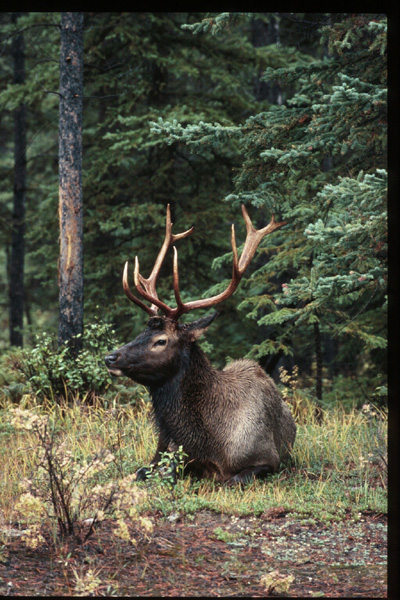 Bull Elk
This bull elk was photographed from my vehicle in Jasper National Park, Alberta, using a telephoto lens
Photo © Jim Robertson, ^http://www.wildwatch.org/Binocular/bino01/empathy.html] Bull Elk
This bull elk was photographed from my vehicle in Jasper National Park, Alberta, using a telephoto lens
Photo © Jim Robertson, ^http://www.wildwatch.org/Binocular/bino01/empathy.html]
.
Outdoor Photographer magazine ran an article in January/February 2000 on “Tips for Photographing Eagles” with the sub-heading “A long lens, the right location and a sensitive approach can get you excellent images of these majestic birds”.
The author of the article, Bill Silliker, Jr. wrote, “If you don’t have a long lens, don’t push it. Ethical wildlife photography requires that we forego attempts to photograph wildlife when we’re not equipped for it or if the attempt might harass or somehow place the subject in jeopardy. Be satisfied with images that show an eagle in its habitat. Editors use those too.”
The other day a neighbour stopped by and, upon seeing the small herd of black-tailed deer who found refuge on my land, asked if I was a hunter. When I said, “No, I’m a wildlife photographer,” he shrugged and replied, “It’s all shooting.”
Well, yes and no.
The obvious, major difference is that the animals “shot” with a camera do not end up dead. But because there are similarities to hunting, many people approach wildlife photography with a similar mind-set. It’s laughable to see photographers in a national park camouflaged from head-to-toe, sometimes including face paint, photographing a bull elk as he calmly grazes alongside the road–fully aware of their presence. And I couldn’t count how many times I’ve seen tourists run right up to a bear, elk, bison, or moose with a tiny disposable camera to get their close-up “trophy” photo.
They seem to think it’s only fair–that they are entitled to get closer–since they don’t have a large telephoto for their camera. But if they were to examine their motives they would realize that their behaviour is not fair to the animal. Is their trophy more important than the well-being of the subject of their photo?
At the height of disregard, some photographers will use hounds fitted with radio collars to pursue and corner bears, bobcats, or cougars for close-up photos of these more elusive species. If they are “lucky”, they might even catch the animal snarling in response–just the way any number of hunting magazines like to portray them on their covers or in juicy, two-page fold-outs. But how would they feel if they had to flee for their lives, chased down by a pack of dogs until they were exhausted or treed, just so someone could get a picture of them?
Wildlife photography should not be thought of as a sport or challenge against nature, or against the animals who did not volunteer for the game. Would it be considered ethical to make sport of photographing unwilling human subjects?
Unethical practices of those who photograph wildlife for self-serving purposes have given the whole field a bad name. Bill McKibben, author of “The End of Nature” has proposed a moratorium on new wildlife photos, to prevent further aggravation of endangered animals. He argues there are plenty of photos already out there for use in prints and publications. As more incidents of unethical behaviour by photographers occur, the privilege of photographing wild animals will become more and more restricted.
Still, no amount of harassment or disruption of wildlife in any way justifies the increasingly popular use of game farms by so-called wildlife photographers.
Too often, the “wild” animal seen in a publication or promotional is actually a captive animal sentenced to life on a game farm. Game farms use high fences, costing upwards of $8,000.00 per mile, to keep their preferred, sometimes exotic species in. These fences also effectively keep the native migratory wildlife out, thereby taking up valuable habitat.
While many game farms profit directly from the hunting of animals in their enclosures, others appear relatively innocuous, charging only for public viewing and private photographic sessions with “wildlife models,” including crowd-pleasing kittens, cubs, or fawns bred specifically for that purpose. But as these animals get older and less photogenic, they are auctioned off as “surplus” to the highest bidders–a common practice of zoos as well. It is likely the same animals that appeared as cute babies on calendars, greeting cards, or other publications will end up a few years later at another game farm that does profit from the canned hunting of them.
.
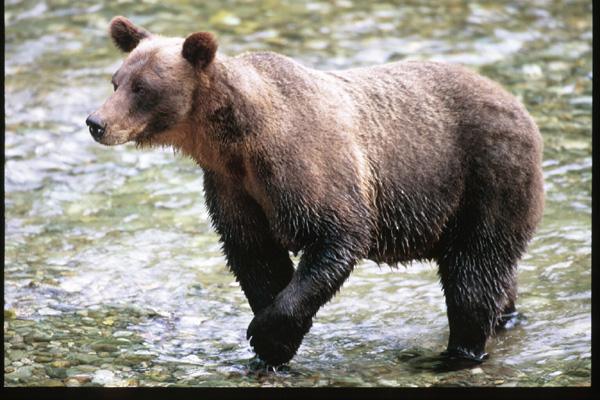 Grizzly Bear Grizzly Bear
This sow grizzly bear was photographed with a 600mm telephoto
from a supervised Forest Service observation platform along Fish Creek, in Southeast Alaska.
Photo © Jim Robertson
^http://www.wildwatch.org/Binocular/bino01/empathy.html]
.
Most photographers and photo editors do not differentiate between wild or captive animals when selling and publishing images. Using photos shot at game farms supports those who profit from exploiting animals by keeping them captive to serve as models for photographers, entertainment for tourists, or targets for trophy hunters. At the same time, these photos set a new, unnatural standard for closeness and intimacy with animals that the public expects to see in every future image.
And while on the subject of ethics, how ethical is it to top off a day of photographing waterfowl or ungulates with a dinner of poultry or red meat?
.
Don’t all living beings deserve our compassion and respect?
.
I had long heard that animals feel less threatened by someone who does not eat meat, but I wondered how long a human could survive without consuming the flesh of others. After six years as a vegan, I can attest to the fact that wild animals are not as fearful of me now, and that saying “no” to animal protein is healthier and easier than I ever would have imagined. >>
.
Sunday, July 21st, 2013
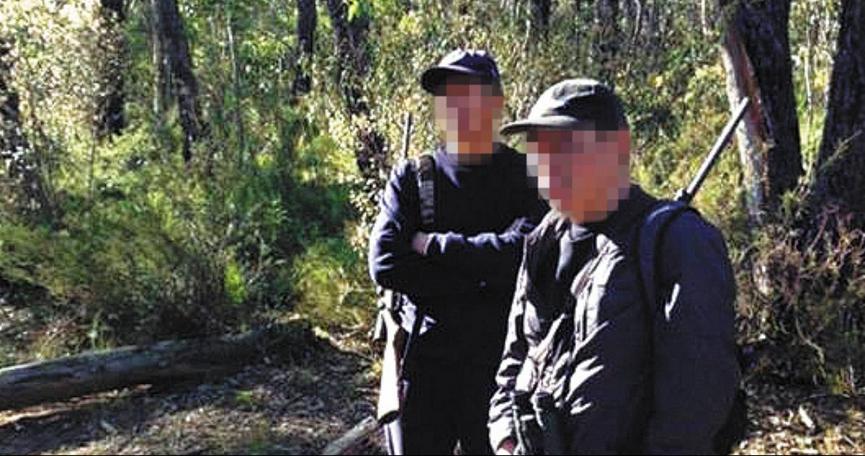 Illegal poachers caught in the Blue Mountains World Heritage Area on 15th June 2013
[Photo by bushwalker Darren Drew in Tigersnake Canyon, Wollemi National Park, at a time when 500 runners were participating in a marathon in the area] Illegal poachers caught in the Blue Mountains World Heritage Area on 15th June 2013
[Photo by bushwalker Darren Drew in Tigersnake Canyon, Wollemi National Park, at a time when 500 runners were participating in a marathon in the area]
.
<< Two men were reported to be illegally hunting in NSW’s biggest natural tourist attraction, the Greater Blue Mountains World Heritage Area.
Blackheath bushwalker Darren Trew said he came across the hunters on a canyoning trip with friends on Saturday June 15. Over that weekend 500 runners from across the state had converged in that same region to participate in the second Glow Worm Tunnel Marathon, near Newnes. Mr Trew, who saw the men with their weapons, reported the matter to Lithgow Police, to the Game Council and to the National Parks and Wildlife Service.
Mr Trew:
“It’s madness. It was quite a shock to discover after 20 or more years of bushwalking. It’s quite disturbing, they said they were hunting deer and I told them they were not allowed to be here with rifles, it’s illegal, I called the police and they walked away.”
.
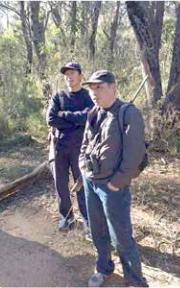 Photo by High & Wild Photo by High & Wild
.
Mr Trew’s group took a photo of the men and said later that day about 20 people turned up to enjoy Tigersnake Canyon.
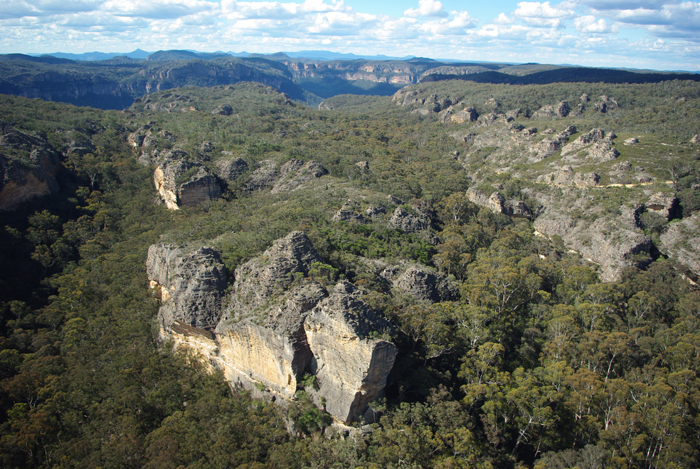 Glow Worm Tunnel Area, Wollemi National Park
Greater Blue Mountains World Heritage Area
[Source: NSW Government, ^http://www.environment.nsw.gov.au/nationalparks/parkWalking.aspx?id=N0051] Glow Worm Tunnel Area, Wollemi National Park
Greater Blue Mountains World Heritage Area
[Source: NSW Government, ^http://www.environment.nsw.gov.au/nationalparks/parkWalking.aspx?id=N0051]
.
Glow Worm Tunnel Marathon race director Sean Greenhill of the Wentworth Falls based Mountain Sports said he was very concerned by the reports.
“It’s extremely disturbing to think that two men with rifles were hunting in a national park only a couple of kilometres from where 500 runners were conducting a legitimate activity in the same park — odds are small but the potential implications are horrifying. Mountain Sports doesn’t support hunting in any national park — why create such a dangerous precedent?”
.
“Unfortunately, some hunters have heard “you can now hunt in national parks” and assume it’s a free-for-all. With the Game Council promoting NSW as ‘the place to hunt’, this is only going to get worse.”
~ National Parks Association of NSW spokesman, Justin McKee
.
National Parks Association of NSW spokesman, Justin McKee:
“The incident highlights that Premier Barry O’Farrell’s promise that safety will be paramount does not definitely rule out the risk of illegal hunting in highly visited areas, including those where hunting is not allowed like the Greater Blue Mountains World Heritage Area.
Hunting in national parks is bad policy, it’s bad for tourism, public safety and the environment. It ruins the international reputation of our national parks brand that has taken 50 years to build up. Unfortunately, some hunters have heard ‘you can now hunt in national parks’ and assume it’s a free-for-all.”
.
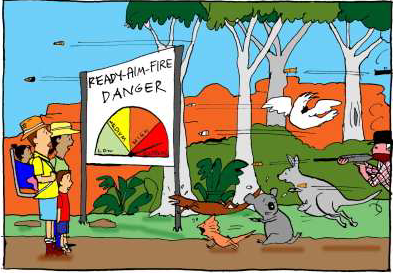
A spokesman for Environment Minister Robyn Parker said the minister didn’t normally comment on operational issues but “obviously hunting in national parks is illegal and an investigation is ongoing”… [Ed: There is no public report that they caught, so it was a free-for-all that day]
[Source: ‘Armed hunters spotted in Blue Mountains world heritage area’, 20130626, by B. C Lewis, Blue Mountains Gazette (newspaper), page 7, ^http://www.bluemountainsgazette.com.au/story/1598489/armed-hunters-spotted-in-blue-mountains-world-heritage-area/; the lead photo of the two hunters was taken near Tigersnake Canyon and posted on Facebook 20130622]
.
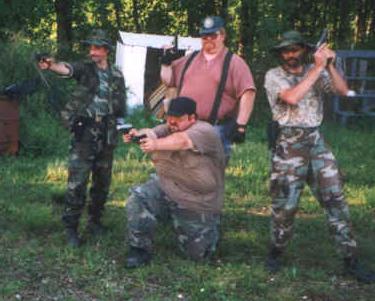 Weekend Warriors
all camoued up and ready to hunt! Weekend Warriors
all camoued up and ready to hunt!
.
Game Council NSW ‘Code of Practice’ (so-called)
.
<< Ethical, safe and responsible hunting
.
- Awareness of relevant legislation
It is the responsibility of the holder of a NSW Game Hunting Licence to be aware of and comply with all relevant legisation relating to hunting, animal welfare and the use of firearms.
- Safe handling of firearms
Where firearms are used, the rules for safe handling set out in the NSW Firearms Safety Awareness handbook, published by or under the authority of the Commissioner of Police, must be complied with at all times.
- Permission required to enter land
A NSW Game Hunting Licence does not automatically authorise the holder of a licence to hunt on any land. The holder of a Game Hunting Licence must not hunt on any land without the express authority of the occupier of the land.
- Target identification and safety
A game animal must not be fired at unless it can be clearly seen and identified, and the shot taken poses no discernible risk of injury to any person or damage to any property.
- Obligation to avoid suffering
An animal being hunted must not be inflicted with unnecessary pain. To achieve the aim of delivering a humane death to a hunted animal:
- it must be targeted so that a humane kill is likely;
- it must be shot within the reasonably accepted killing range of the firearm and ammunition or bow being used; and
- the firearm, ammunition, or bow and arrow, must be such as can be reasonable expected to humanely kill and animal of the target species.
- Lactating female with dependent young
If a lactating female is killed, every reasonable effort must be made to locate and kill any dependent young.
- Wounded animals
If an animal is wounded, the hunter must take all reasonable steps to locate it so that it can be killed quickly and humanely.
- Use of dogs
Dogs and other animals may be used to assist hunters, but only if:
- their use is not in contravention to the Prevention of Cruelty to Animals Act 1979; and
- their use is with the permission of the occupier of the land concerned. >>
.
[Source: Game Council of NewSouth Wales, ^http://www.gamecouncil.nsw.gov.au/portal.asp?p=CodeofPractice]
.
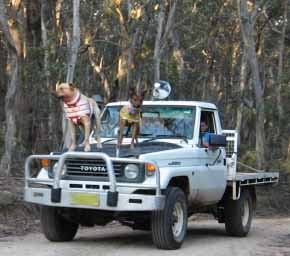 Game Council Code of Practice:
“Use of (pig) dogs: Dogs and other animals may be used to assist hunters, but only if: Game Council Code of Practice:
“Use of (pig) dogs: Dogs and other animals may be used to assist hunters, but only if:
-
their use is not in contravention to the Prevention of Cruelty to Animals Act 1979; and
-
their use is with the permission of the occupier of the land concerned.”
.
May 2012: NSW Government allows hunting in national parks
.
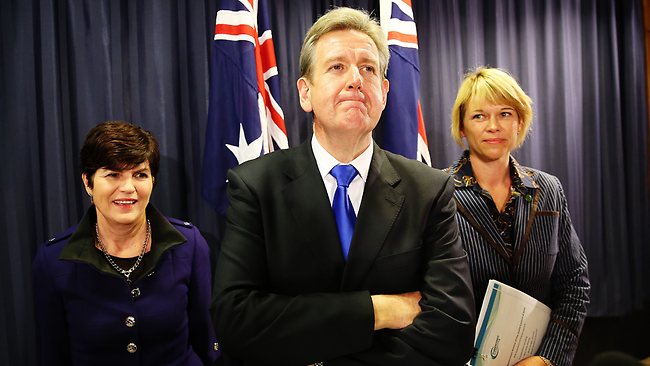 National Park’s chief custodian Environment Minister Robyn Parker,
with NSW Premier Barry O’Farrell and Primary Industries Minister Katrina Hodgkinson
announcing that shooting will be legal in national parks.
[Source: Photo by Craig Greenhill, The Daily Telegraph] National Park’s chief custodian Environment Minister Robyn Parker,
with NSW Premier Barry O’Farrell and Primary Industries Minister Katrina Hodgkinson
announcing that shooting will be legal in national parks.
[Source: Photo by Craig Greenhill, The Daily Telegraph]
.
<< Hunting will be seen in 79 of the state’s national parks as part of a deal struck by the government (with the Christian Democrats and the Shooters and Fishers Party) last night in exchange for the sale of the state electricity generators.

New South Wales Premier, Barry O’Farrell: “We promised to revitalise the state’s economy, we promised to put additional funding into infrastructure… and the decision was based on the public interest and political realites.”
Despite O’Farrell’s pre-election promise that he would not open up national parks to shooters as hunting reserves, the Premier said that he has not broken his promise.
“There is a big difference between hunting reserves and restricted shooters under the direction of the Minster of the Environment assisting National Parks and Wildlife staff with the culling of feral animals.”
O’Farrell’s famous last words:
“Shooting will be safely and professionally run by the Game Council.”
.
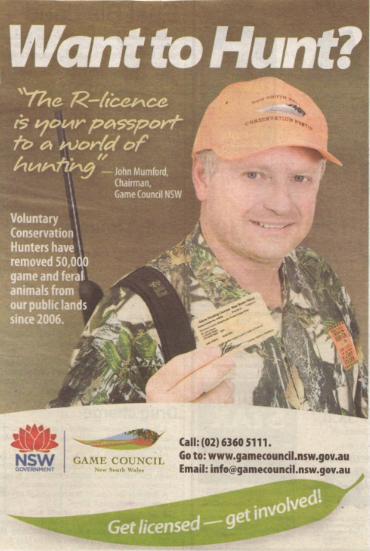
In exchange for the hunting deal Premier O’Farrell will now be able to sell off the state’s generators as recommended by the State’s Commission of Enquiry…>>
[Source: ‘Premier O’Farrell to allow hunting in NSW national parks’, 20120531, by Amy Taylor-Kabbaz, Australian Broadcasting Corporation, ^http://www.abc.net.au/local/stories/2012/05/31/3515093.htm]
.
ABC radio interview by radio presenter Adam Spencer with Premier Barry O’Farrell, 20120531:

Listen to ABC radio interview
.
[Ed: So a month later on 27th June 2012, the NSW Coalition Government, the Shooters and Fishers Party and the Christian Democratic Party voted in changes to legislation that allows amateur, recreational hunting to occur in NSW National Parks.]
.
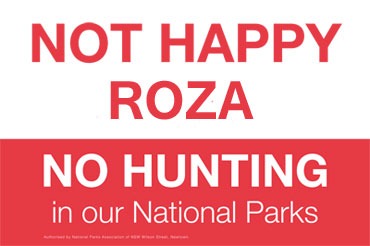 Blue Mountains protest campaign against the NSW Government’s local representative, Roza Sage MP,
and her undemocratic support for hunting in national parks across New South Wales. Blue Mountains protest campaign against the NSW Government’s local representative, Roza Sage MP,
and her undemocratic support for hunting in national parks across New South Wales.
.
Two weeks later, on Sunday 15th July 2012, about 400 people rallied in Katoomba in the Blue Mountains to protest against Barry O’Farrell’s decision and to tell local Blue Mountains MP Roza Sage that they oppose the Government’s decision to allow hunting in our National Parks.
.
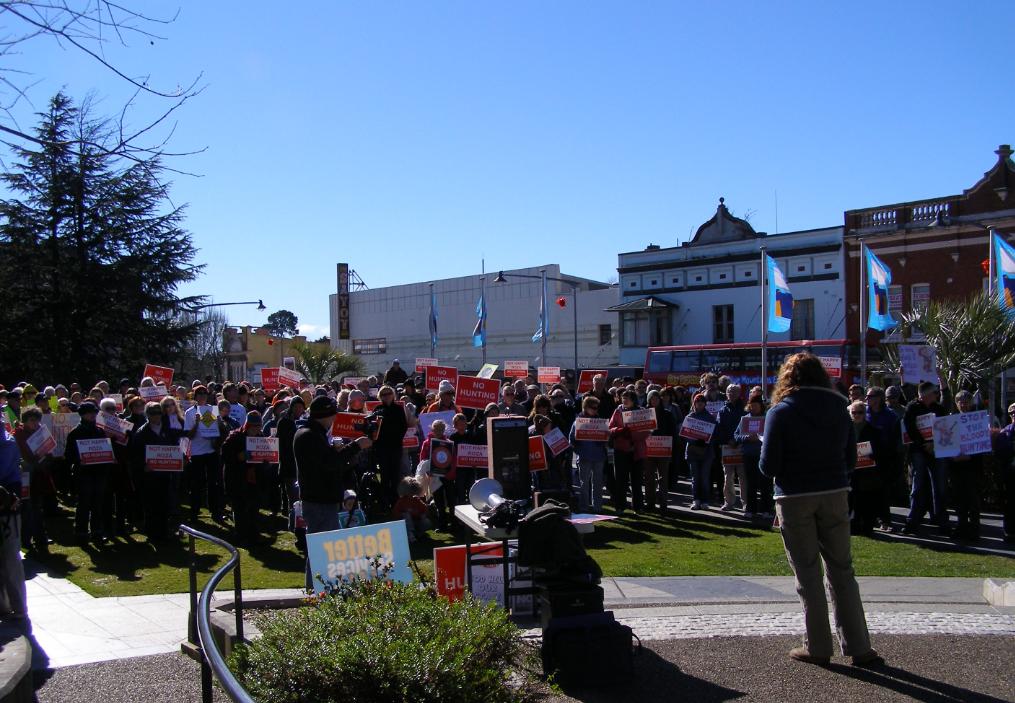 No Hunting in National Parks Rally at Katoomba
[Photo by Editor 20120715, photo © under ^Creative Commons] No Hunting in National Parks Rally at Katoomba
[Photo by Editor 20120715, photo © under ^Creative Commons]
.
Kangaroo shot with arrow in Kosciuszko National Park
.
 Conservation Hunting Conservation Hunting
.
This kangaroo was discovered, still alive, two days ago near Log Bridge Creek picnic and camping ground on the Blowering Foreshore inside the Kosciuszko National Park, with the arrow right through its upper body.
<< An illegal hunter shot a kangaroo with an arrow and left it wounded near a camping area in the Kosciuszko National Park.
The roo was discovered yesterday near the Log Bridge Creek picnic and camping area on the Blowering Foreshore and was put down by parks officers.
NSW National Parks and Wildlife Service regional manager Dave Darlington:
“This roo spent an unknown time with an arrow pierced fully through its body and the cruelty and atrocity of this act is horrific. This is a senseless and disgusting act and we hope to prosecute the person responsible to the furthest limits of our legislation.”
Anyone with information is urged to phone NPWS on (02) 6947 7000 or Crime Stoppers on 1800 333 000.
.
Harming protected wildlife carries penalties of $11,000 an incident and up to six months jail while having a bow and arrow in a National Park also carries a fine of up to $3,300.
.
The National Parks and Wildlife Service had to euthanise a kangaroo.
[Source: ‘Kangaroo found shot with arrow’, 20130703, ABC News, ^http://www.abc.net.au/news/2013-07-03/kangaroo-found-shot-with-arrow/4796178]
.
National Parks and Wildlife Service does drug deal with hunters
.
<< A National Parks and Wildlife Service ranger was stood down for allegedly letting hunters into the Paroo-Darling National Park in the state’s far west in exchange for drugs.
The government confirmed there had been 12 investigations of illegal hunting in national parks in the past year.
The state government is soon to decide whether to press ahead with its plans to allow shooting in national parks. Allowing hunting in national parks was agreed to in a deal between the government and the Shooters Party so the Shooters would pass the $5 billion sale of the ports through the upper house. Premier Barry O’Farrell is expected to take a risk assessment on the hunting plan to cabinet in the next fortnight at the same time as a review by former senior public servant Steve Dunn on the structure of the shooting regulator, the Game Council.
The Dunn report was ordered after the acting chief executive of the Game Council was allegedly caught illegally shooting on the eve of the intended opening of national parks to shooters. Mr Dunn’s report will recommend that all shooting advocates and members of the Shooters Party no longer serve on the board of the Game Council, because of a clear conflict between the roles of advocate and regulator. [Ed: Download the Dunn Report at the end of this article]
Illegal hunters trespassing on private land in metro Sydney
.
<< Hunters using guns and crossbows have been illegally entering private properties in metropolitan Sydney, forcing ecologists to abandon night-time observation of frogs and owls for fear of being shot.
Incidents have occurred in the past fortnight in north-west Sydney, just a few kilometres from housing, according to UBM Ecological Consultants’ Judith Rawling. The situation has become dangerous for her staff, she said, and she attributed the surge in illegal hunting to publicity over the looming introduction of hunting in national parks.
Local environment planning drafts for the Hills Shire have been released, prompting residents of bush blocks to apply for subdivisions.
”Before you put in a [development application] you have to put in a flora and fauna survey … That’s why we are coming across these shooters. This is really dangerous,” she said.
Game Council NSW was unavailable for comment.
Greens MP and firearms spokesman David Shoebridge:
“If local councils, the police and Game Council can’t control illegal hunting in the Hills Shire, there is no way on earth they will be able to regulate amateur hunting in far-flung national parks.”
.
[Source: ‘Hunters prowl across private land near city’, 20130630, by Kirsty Needham, Sydney Morning Herald (newspaper), ^http://www.smh.com.au/environment/animals/hunters-prowl-across-private-land-near-city-20130629-2p3v4.html]
.
Hunters shoot at a farmer near Game Council headquarters
.
May 2013:
.
<< Orange police are looking for two men who shot at a Springside farmer yesterday morning when he caught them illegally hunting on his property. [Ed: Springside is a community just south of Orange in central western New South Wales, where the Game Council of NSW has its headquarters].
The 43-year-old landowner was bailed up at gunpoint and ordered to drop his mobile phone which he was using to take a photograph of the offenders’ number plate. One of the gunmen smashed the phone and fired a warning shot at the man’s feet.
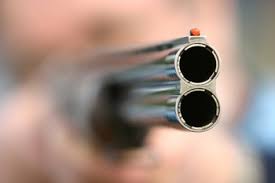
The farmer had challenged the men after he found them on his property hunting kangaroos. [Ed: Conservation Hunting?]
Canobolas Local Area Command Inspector Dave Harvey said the two men were less than four metres away from the farmer when they shot at him.
A command post was set up at Springside shortly before 10am where five police, detectives and the forensics special group combed through bushland in the Canobolas State Forest for two hours looking for the men. One of the men was wearing a grey top and black tracksuit pants. He is described as Caucasian, about 180cm tall, thin build with short dark hair and is between 17 and 24 years old. They were driving a white Subaru Outback.
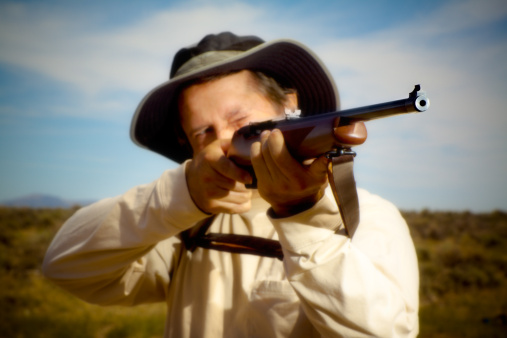
June 2013:
.
<< Orange police have charged an 18-year-old man over last month’s shooting at Springside. The man is believed to be one of two people who shot at a farmer while illegally shooting on his property on May 21 at around 9.30am.
The alleged shooter was arrested in Orange’s central business district at around 11.50pm yesterday. Yesterday afternoon police obtained a search warrant for his Moad Street apartment where they found a number of items which police believe may be associated with the gun used in the shooting. Canobolas Local Area Command Acting Inspector Brenden Turner said police had not located the firearm. >>
.
[Source: ‘Hunters shoot at property owner’, 20130522, by Nicole Kuter, Central Western Daily (Orange-based newspaper),^http://www.centralwesterndaily.com.au/story/1517209/hunters-shoot-at-property-owner/; and ‘Hunter Police get their man: charges over hunting shooting’, 20130627, by journalist Tracey Prisk, Central Western Daily, ^http://www.centralwesterndaily.com.au/story/1599702/police-get-their-man-charges-over-hunting-shooting/?cs=103]
.
NSW Game Council bosses above the law?
.
<< The state government’s plan to allow hunting in national parks is in turmoil after the acting head of the Game Council was stood down on suspicion of illegal hunting.
The council is the body that will issue shooting licences under the scheme. Its acting chief executive, Greg McFarland was suspended on Tuesday night – along with a colleague – by the Primary Industries Minister, Katrina Hodgkinson, after Fairfax Media learnt of a police investigation into an incident near Mount Hope in central west NSW.
 Game Council’s acting chief executive, Greg McFarland
is currently the subject of continuing investigations
[Source: ‘Game Council to be abolished’, 20130704, by Sean Nicholls, Sydney Morning Herald State Political Editor Game Council’s acting chief executive, Greg McFarland
is currently the subject of continuing investigations
[Source: ‘Game Council to be abolished’, 20130704, by Sean Nicholls, Sydney Morning Herald State Political Editor
http://www.smh.com.au/nsw/game-council-to-be-abolished-20130704-2pdte.html]
.
<< Rural crime investigators confirmed they are looking into claims of illegal hunting and trespass and the inhumane killing of a feral goat. They plan to interview Mr McFarland…
At the centre of the investigation is a Game Council vehicle that was seen being driven through a national park without permission before allegedly breaking a fence and entering the privately-owned Karwarn cattle station in pursuit of a male goat with ”trophy horns”.
.
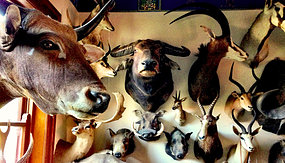 The Hunting Party
(Photo by Louie Eroglu) The Hunting Party
(Photo by Louie Eroglu)
.
According to photographs taken by the owner of the 25,000-acre property, Diane Noble, the goat was shot in the gut – an act that contravenes the council’s own guidelines on humane, ”single shot” kills. Hunters sometimes avoid shooting a goat in the head to ensure the skull and horns can be hung as a trophy.
The incident happened on December 28 at the Noble’s Karwarn station, 110 kilometres south of Cobar. According to Ms Noble, the pair were confronted by a group of hunters who had paid to shoot at Karwarn. To access Karwarn, the pair had to drive through the Yathong Nature Reserve, run by the National Parks and Wildlife Service. A parks source confirmed they did not have appropriate permission to do so.
.
“If local councils, the police and Game Council can’t control illegal hunting in the Hills Shire, there is no way on earth they will be able to regulate amateur hunting in far-flung national parks.”
~ Greens MP and firearms spokesman David Shoebridge
.
..The suspensions call into question the O’Farrell government’s insistence that shooting will be safely and professionally run by the Game Council, which will issue licences and monitor compliance when shooting begins on March 1. Critics said the government must now reconsider its deal with the Shooters and Fishers Party to put the council in charge or abandon hunting in national parks altogether.
Steve Turner, the assistant general secretary of the Public Service Association, which represents park rangers, said: ”How can anyone have faith that hunting in national parks will be run safely? Imagine what’s going to happen when the rogues get going.”
The scandal comes a month after a risk assessment written by Premier Barry O’Farrell’s own department emerged, warning of a ”major risk” that bushwalkers and parks staff will be killed or seriously injured.
Ms Noble said she did not want to prejudice the investigation but was angered by the apparent conduct. ”The Game Council is supposed to promote ethical hunting. They shot the goat through the guts and that’s not ethical,” she said. ”The animal should be shot once in the head or the heart and lungs for a quick kill.” >>
.
[Source: ‘Game boss suspended over illegal hunt claim’, 20130123, by Heath Aston (political reporter), Sydney Morning Herald, ^http://www.smh.com.au/nsw/game-boss-suspended-over-illegal-hunt-claim-20130122-2d5nn.html]
.
July 2013: Time to Wind Up the Game Council racket
.
Dunn’s Review into the Governance of the Game Council was commissioned by the Government after an internal investigation into allegations that a senior member of the Council had been involved in the inhumane killings of the goat in Western NSW.
.
<<On Thursday 4 July 2013 the NSW Government announced it will implement the key changes to Game Council NSW recommended by the independent Governance Review of the Game Council of NSW by Steve Dunn, popularly referred to as The Dunn Report.
The changes are designed to improve the functions previously carried out by Game Council NSW and also acknowledge hunting as a legitimate recreational activity.
The report found that Game Council NSW had an ‘inherent conflict associated with its functions to both represent the interests of hunters, and to regulate their activities’.
Therefore the NSW Government said it will immediately take the following actions:
- Transfer the licensing, regulatory, enforcement, education and policy functions into the NSW Department of Primary Industries (DPI); and
- Establish an advisory Game Board that will undertake stakeholder engagement and representation, advocate hunting, advise on research priorities and commission research, and provide independent advice to Government.
The Director General of NSW Trade & Investment, Mr Mark Paterson AO, will become the Division Head of the Game Council Division in the interim to oversee the integration of functions into DPI.
The NSW Government also announced it will immediately suspend hunting in all 400 State forests, pending the transfer of functions and the outcome of a risk assessment. This means that individuals with written permission to hunt on declared public land areas such as State forests and Crown Lands must no longer do so and must abide by the suspension until further advised.
Game Council and the Forestry Corporation of NSW will be contacting licence holders who have booked Written Permissions as soon as possible. Advice is also being sought from the NSW Government on the status of licensing arrangements.
Game Bird Management regulatory functions will continue to be undertaken by the Office of Environment and Heritage in 2013 and will transfer to DPI in 2014.
.
Game Council NSW Media Statement
.
<<On Thursday 4th July 2013, the Minister for Primary Industries announced the dissolution of Game Council NSW as a result of recommendations made following the NSW Government’s governance review.
The NSW Government has suspended hunting in all NSW State forests, pending a new risk assessment. All issued Written Permissions are now invalid. Game Council and the Forestry Corporation of NSW will attempt to call all licence holders with bookings to confirm cancellation of their permits in the coming week.
Game Council is committed to working with the NSW Government as the report recommendations are implemented and will also be working closely with NSW game hunting licence holders to minimise the impact of interim arrangements. >>
[Source: Game Council NSW website, ^http://www.gamecouncil.nsw.gov.au/]
.
..Minister for Primary Industries (DPI), Katrina Hodgkinson MP said nominees for the board would be ministerially appointed based on merit and all existing 21 staff under the current Games Council would be transfered to the new structure under the DPI.
She said key in her decision to support Steve Dunn’s report recommendations was its finding that “more than a decade after it was established the Game Council has no overarching governance framework; lacks a strategic planning framework; lacks some of the skills, tools and resources to ensure effective compliance with its regulatory framework; has no internal regulatory compliance program, has no approved enterprise-wide risk management framework and has an inadequate policy framework”.
“I can’t just stand by and allow that to continue – I take full responsibility for the changes,” Ms Hodgkinson said.
She said one of her primary concerns was for staff employed in the area of compliance and their safety, but she also saw the need to restore confidence in the public in this area. >>
.
COMMENT by ‘Dickytiger’ 20130705:
.
“Good move. The Game Council was just a Shooters Party lurk, looking after their mates.
Hunting feral animals is vital, but it doesn’t require a crony bureaucracy to do it.”
.
[Source: ‘Game over as hunting suspended’, 20130704, by Andrew Norris, The Land (rural newspaper), ^http://www.theland.com.au/news/agriculture/general/news/game-over-as-hunting-suspended/2663149.aspx?storypage=0]
.
Game Council NSW to be abolished
.
<< Amateur hunting in NSW forests will be suspended until at least October following the damning findings of a review into the Game Council of NSW.
As a result of the review, by retired public servant Steve Dunn, the Game Council of NSW will be abolished and responsibility for licensing of amateur hunters transferred to the Department of Primary Industries, the state government announced on Thursday.
The concerns raised in the review have led the government to announce the suspension of all amateur hunting in state forests until governance issues identified within the council are resolved.
In a simultaneous announcement, Environment Minister Robyn Parker revealed the introduction of amateur hunting to national parks will proceed in October, but on a trial basis in 12 parks. Pending the results, hunting may be rolled out in up to 75 parks and reserves as previously announced by the government under a deal with the Shooters and Fishers Party.
Ms Parker said the rules for shooting in national parks would be significantly different to those in place for state forests. Shooters would be closely supervised by National Parks and Wildlife staff in all areas where shooting takes place, which will be closed to visitors for the duration. Shooting will not take place during school holidays.
Additionally, no one under 18 would be allowed to participate, and use of bows or black powder muskets would be prohibited.
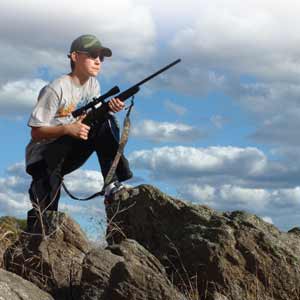
The Dunn report, released on Thursday, slams governance the Game Council, which it says is ‘‘deeply embedded in politics’’.
In a scathing assessment, Mr Dunn says public safety ‘‘does not receive a high level of attention’’ in planning documents prepared by the organisation, which is responsible for overseeing licensing of amateur shooters in NSW.
He says the council has been unable to resolve the ‘‘inherent conflict of interest’’ between representing the interests of hunters and regulating their activities in NSW.
The report says the council has ‘‘achieved significant results’’ since its establishment in 2002. But they have been achieved ‘‘at the taking of governance risks not normally associated with government bodies.’’
It concludes: ‘‘Allowing the Game Council to continue on its current path is not an option.’’
The review was ordered by Mr O’Farrell in March after an investigation found alleged illegal hunting by two Game Council senior employees on a property in outback NSW.
.. The IAB report also identified ‘‘possible breaches of Game Council policies and procedures, information which raises questions about governance procedures within the Game Council’’.
Sensitivity over the allegations were heightened by the decision by Mr O’Farrell to open NSW national parks to amateur hunting.
The decision was part of a deal between the government and the Shooters and Fishers Party, which holds the balance of power in the upper house, over passage of electricity privatisation legislation.
Mr Dunn’s report notes that the Game Council was established in 2002 because of the ‘‘influence and power’’ of the Shooter and Fishers Party. He says this power has resulted in the creation of an organisation lacking in accountability.
Shooters and Fishers Party MP Robert Brown is a former Game Council chairman.
More than a decade after the Game Council was established, a strategic plan has yet to be finalised and made public, Mr Dunn notes. His report recommends the 18-member Game Council be replaced by a NSW Game Board of not more than eight members.
It would be subject to control of the department and be responsible for representing the interests of hunters, promoting feral animal control and providing policy advice to government.
However, licensing, education and law enforcement functions – currently the chief role of the Game Council – would be handed to a government department, along with policy and legislation functions. Reaction is being sought from Game Council chief executive Brian Boyle and the Shooters and Fishers Party. >>
[Source: ‘Game Council to be abolished’, 20130704, by Sean Nicholls, Sydney Morning Herald State Political Editor, ^http://www.smh.com.au/nsw/game-council-to-be-abolished-20130704-2pdte.html]
.
Hunting on NSW public land will be banned for at least the next two months and the Game Council will be disbanded. Yet the NSW Government is going ahead with its plan to allow volunteer hunters in national parks as part of a pest control program.
It’s a bold decision, which the Shooters and Hunters Party says even it had no idea was coming. This decision stems from the results of the Government commissioned Dunn Review into the governance of the Game Council. >>
.
Dunn’s Scathing Review
.
Dunn’s Review into the Governance of the Game Council was commissioned by the Government after an internal investigation into allegations that a senior member of the Council had been involved in the inhumane killings of a goat in Western NSW.
The final report acknowledged the Council had achieved many things in its years of operation but for the most part the report was undeniably shocking leaving the Government no choice but to take action.
Its author Steve Dunn questions how things got so bad. He found the Council has no overarching governance framework, lacks the skills and resources to ensure effective compliance and found breaches of record keeping and privacy legislation. The Game Council is a statutory body established under the Game and Feral Animal Control Act – and it should be subject to the control and direction of the Minister for Primaries Industries.
But Premier of NSW, Barry O’Farrell, says the Council strayed.
“Essentially it made the point that the Game Council was both the promoter and the operator in relation to hunting activities across NSW as well as the regulator,” he said. “That posed an unacceptable risk to the Government.”
The review found the Game Council has its fingers deep in the political pie, with the slices getting bigger thanks to the influence and power of the Shooters and Fishers Party in the NSW Legislative Council.
Steve Dunn wrote, “the Game Council has no parent and no siblings, no one wants to adopt it and no one really wants a close relationship with it, because of the politics.”
Shooters Party MP, Robert Brown, says he hasn’t yet had time to fully consider the O’Farrell Government’s announcement. But he says he’s personally disappointed the Game Council has been abolished and will be seeking a meeting with the Premier before he forms the Party’s response.
The Game Council will be replaced by an advisory board of no more than eight members, which will each be selected on merit, rather than being appointed by various organisations. The board will be in charge of advocacy. The regulatory aspect of the Council will now go to Department of Primary Industries.
Minister Katrina Hodgkinson says no Games Council jobs will be lost in the transition and, until that situation is fixed, shooting in state forests has been put on hold.
“It’s a hard thing to have to go through and accept a report which is so critical of an organisation. But we’ve got an opportunity now to make things right and make things good. We’ll be transferring the operations of the Game Council over into the Department of Primary Industries, which does have excellent governance.”
The temporary shooting stoppage will affect 400 state forests and 2 crown lands. However the Government is going ahead with its pest control program National Parks.
A trial in 12 parks will commence in October. The Environment Minister Robyn Parker says it will be regulated and managed by the National Parks and Wildlife Service, and there will be strict controls and supervision.
The Minister acknowledged the 20,000 hunters in NSW that assist the Government with pest animal control in NSW.
“These hunters have played an important role in pest eradication.”
The Game Council and the Shooters and Fishers Party have been contacted for comment.
A one time candidate of the Shooters and Fishers Party says he’s always had concerns about the way the Game Council has been run. Jim Pirie is from Mudgee in New South Wales and has over 60 years of hunting experience under his belt, he was also a one-time candidate of the Shooters and Fishers Party. These days he’s the owner of a gun shop in town and he’s also the Treasurer of the Cudgegong Valley Hunters Club.
He spoke with the ABC’s Angela Owens frankly about his concerns over opening National Parks up to hunters and the growing power base of the Game Council.
.
“Unfortunately the architects of all this are very egotistical, arrogant men and they won’t take advice from anybody,” he said. “It’s either their way or the highway.”
.
“(Someone) stood up at a hunting organisation meeting one day and said there was no nepotism, no cronyism in the Game Council, well that was a joke.
“They appointed the people that they wanted and this at the end of the day was to the determent of the organisation.” >>
.
[Source: ‘NSW Government abolishes Game Council’, 20130705, by Skye Manson, Lisa Herbert and Angela Owens, ABC Rural, ^http://www.abc.net.au/news/2013-07-05/nrn-game-council-gone/4800282]
.

.
July 2013: Cowboy shooters are finished in NSW
.
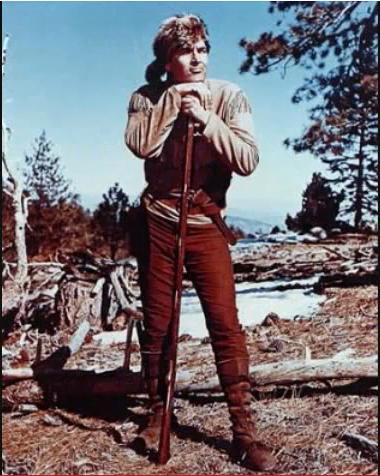 Daniel Boone was a big man Daniel Boone was a big man
.
“DANIEL BOONE”
lyrics by Vera Matson, music by Lionel Newman
.
<< Daniel Boone was a man,
Yes, a big man!
With an eye like an eagle
And as tall as a mountain was he!
Daniel Boone was a man,
Yes, a big man!
He was brave, he was fearless
And as tough as a mighty oak tree!
From the coonskin cap on the top of ol’ Dan
To the heel of his rawhide shoe;
The rippin’est, roarin’est, fightin’est man
The frontier ever knew!
Daniel Boone was a man,
Yes, a big man!
And he fought for America
To make all Americans free!
What a Boone! What a doer!
What a dream come-er-true-er was he!
Daniel Boone was a man!
Yes, a big man!
With a whoop and a holler
he c’d mow down a forest of trees!
Daniel Boone was a man!
Yes, a big man!
If he frowned at a river
In July all the water would freeze!
But a peaceable, pioneer fella was Dan
When he smiled all the ice would thaw!
The singin’est, laughin’est, happiest man
The frontier ever saw!
Daniel Boone was a man!
Yes, a big man!
With a dream of a country that’d
Always forever be free!
What a Boone! What a do-er!
What a dream-come-er-true-er was he! >>
.
[Source: ‘DANIEL BOONE’, lyrics by Vera Matson, music by Lionel Newman, Twentieth Century Music Corporation, 1964, New York, NY, USA, ^http://www.danielboonetv.com/themesong.html]
.
The Game Council’s Cowboy Days Are Over
.
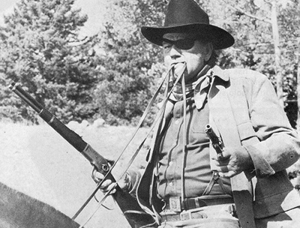
<< The cowboy days are over for the recreational shooting of feral animals in NSW. A damning exposé of what the hunting regulator, the Game Council of NSW, has been up to over the past decade- written by a senior public servant who grew up in rural England, familiar with gun safety – makes astonishing reading.
Steve Dunn describes a politically untouchable posse of gun wielding vigilantes, who enthusiastically set themselves the goal of stopping illegal hunting – despite this actually being the job of police. Dunn says the Game Council was acting beyond its statutory role, and with an inherent conflict of interest. Ultimately they posed an unacceptable risk to the government. The Game Council has now been disbanded by the O’Farrell government.
Boring paper pushing, policy making, analytical or investigations skills weren’t seen as important to this bunch of Wild West public servants. The top job prerequisite to become a game council officer was to be a hunter, and to promote hunting.
Left to their own devices by successive ministers, the game council roamed forest frontiers from its head office in Orange, apparently unconcerned about issues of public safety, promoting their own novel concept of ”conservation hunting”, and cloaked from government oversight.
The Game Council’s website last week boasted of a surge of dead animals last financial year: a ”staggering” 1.23 million animals killed on private land by its hunters, and 21,000 shot on public land. And that these figures meant a 70 per cent increase in its key performance indicator.
But Dunn says the council was confused about its role under the Act. It wasn’t supposed to be tallying carcasses, but instead developing plans for hunter safety, public land access, licensing, education, compliance of licensed hunters and research.
The council considered themselves to be outsiders to other government agencies, who reported the renegades to be combative, assertive, and too aligned with the interests of the hunters they were supposed to be regulating.
The review described a pariah that no other government department could love. If agencies are generally organised into clusters, with small agencies needing both a parent and siblings to survive, the game council was an orphan.
”The Game Gouncil has no parent and no siblings, no one wants to adopt it, and no one really wants a close relationship with it – because of politics,” Dunn wrote.
Established in 2002 under the Labor government, the council had its roots ”deeply embedded in politics”, and arose because of the importance of the Shooters & Fishers Party to the government of the day in the upper house when governments needed to get legislation passed.
.
The council complained it had an image problem in the wider community. But Dunn’s report considers it was a problem of the council’s own making.
.
Carrying private firearms in agency vehicles and hunting on the job are not a good look for public servants. Was it appropriate for the hunting regulator to be handing out promotional stress balls that say ”Stressed? Go conservation hunting”?
In the fallout from the Dunn Review, the Game Council’s regulatory, enforcement, licensing and policy roles have now been transferred to the department of primary industries. A separate advisory Game Board will be formed to represent hunters and advocate hunting.
As the government prepares to allow licensed volunteer shooters to be involved in supervised National Parks and Wildlife Service culls of feral animals in 12 national parks in October, the cowboys that once reigned are out. Strict guidelines for the culls, which will only be held when parks are closed to the public, stipulate: no night shooting, no dogs, no bows and arrows – and no shooting from horses. >>
.
[Source: ‘Cowboy shooters are finished in NSW’, 20130707, by Kirtsy Needham, Illawarra Mercury newspaper, ^ http://www.illawarramercury.com.au/story/1621471/cowboy-shooters-are-finished-in-nsw/]
.
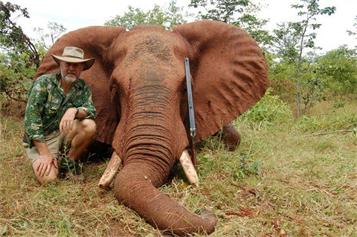 Shooters Party, Robert Borsak with his Big Game kill
~ an African Bull elephant shot on safari in Zimbabwe in June 2008.
[Source: ABC Four Corners, ^http://www.abc.net.au/news/2013-06-11/nsw-mp-robert-borsak-with-an-elephant-shot-on/4745476] Shooters Party, Robert Borsak with his Big Game kill
~ an African Bull elephant shot on safari in Zimbabwe in June 2008.
[Source: ABC Four Corners, ^http://www.abc.net.au/news/2013-06-11/nsw-mp-robert-borsak-with-an-elephant-shot-on/4745476]
.
<< New South Wales Shooters MP Robert Borsak says there has been a culture war over gun control in Australia since the Port Arthur massacre, but he believes people are starting to “get over it.” Mr Borsak believes semi automatic weapons, which were banned in the wake of the 1996 massacre, should be put back in the hands of hunters and recreational shooters. >>
[Source: ‘NSW Shooters MP Robert Borsak says people are ‘getting over’ the Port Arthur massacre’, ^http://www.byronevents.net/nohunting/index.html]
.
.
Further Reading:
.
[1] The Dunn Report (The Governance Review of the Game Council of NSW by Steve Dunn of Independent Consulting, 14th June 2013)
.
ABC Four Corners, ^http://www.abc.net.au/news/2013-06-11/interview-with-robert-borsak-nsw-shooters-and/4745720
.
^http://www.abc.net.au/news/2013-06-11/nsw-mp-robert-borsak-with-an-elephant-shot-on/4745476
.
^http://www.abc.net.au/news/2013-06-11/shooters-mp-says-people-27getting-over27-port-arthur/4745472
.
^ABC, 20130715, ^http://www.abc.net.au/pm/content/2013/s3803487.htm
.
ABC, 20130720, ^http://www.abc.net.au/site-archive/rural/sa/content/2013/02/s3693724.htm
.
‘The Hunting Party’, 20130610, ABC,^http://www.abc.net.au/4corners/stories/2013/06/10/3776198.htm
.
A controversial plan to allow hunting in 79 national parks including the Paroo-Darling National Park in far west NSW near White Cliffs has been delayed indefinitely, 20130220, ABC, ^http://www.abc.net.au/local/audio/2013/02/20/3694440.htm
.
Tags: Game Council NSW, Greater Blue Mountains World Heritage Area, hunting in national parks, Kangaroo shot, Kosciuszko National Park, national parks, NSW Government, poachers, Shooters and Fishers Party, Shooters Party MP Robert Borsak, shooting in national parks, The Dunn Report, weekend warriors, wildlife poaching
Posted in Australian Alps (AU), Blue Mountains (AU), Kangaroos and Macropods, Threats from Poaching and Poisoning | No Comments »
Add this post to Del.icio.us - Digg
Wednesday, July 10th, 2013
 They’re only Kangaroos
..Canberra just needs to expand, so it is easier to just get rid of the native kangaroos.
Katy Gallagher, ACT Chief Minister for Canberra and not much else. They’re only Kangaroos
..Canberra just needs to expand, so it is easier to just get rid of the native kangaroos.
Katy Gallagher, ACT Chief Minister for Canberra and not much else.
.
Katy’s blood lusting for another 2,000 Canberra Kangaroos
.
Katy Gallagher‘s ACT Government want to kill off thousands of pesky kangaroos so that Canberra can develop and expand its housing further into kangaroo feeding grounds.
<< The ACT Civil and Administrative Tribunal today has approved Gallagher’s government licences for kangaroos to be culled at seven sites around Canberra.
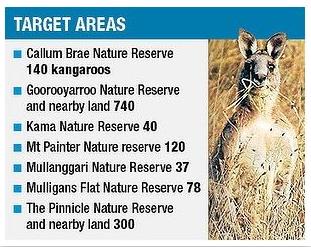
Appeal President Bill Stefaniak and Senior Members Allan Anforth and Adrian Davey varied some of the licences so that only 1244 kangaroos could be shot, not the 1455 originally approved the Conservator of Flora and Fauna. >>
.
[Ed: So Stefaniak has justified that 211 fewer kangaroos seems probably about right. Kill the rest?]
.
<< The seven reserves will be closed at Midday on Thursday to allow culling to take place before the end of July. Animal liberationists have vowed to try and disrupt the shooting of kangaroos in ACT nature reserves after a tribunal approved a scaled-back culling operation..
Carolyn Drew:
“Activists will protest at all seven sites but concentrate much of their efforts on the Goorooyarroo Nature Reserve where a licence has been granted for 740 kangaroos to be culled. We will focus on very intensely on that particular reserve. But the other reserves will also have teams of activists who sit around the various gates so we wait, watch and then we take action as needed.
Many more kangaroos than the 1,244 could die because the figure did not take into account small dependant animals that would be orphaned. “It’ll be within the range of closer to 2,000 that they’ll end up killing if they manage to kill that many.” 2,000 that they’ll end up killing if they manage to kill that many.”
.
The Australian Society for Kangaroos launched action in the tribunal in June to stop the cull.
The Tribunal accepted evidence from government ecologist Don Fletcher that an appropriate number of kangaroos per hectare was between 0.6 and 1.5, which The Government aimed to have one kangaroo per hectare. But the tribunal decided that the cull should aim to leave about 1.5 kangaroos per hectare.
The Australian Society for Kangaroos expert witness, Raymond Mjadwesch, had told the tribunal that it was ecologically appropriate for several more kangaroos per hectare to live on the reserves.
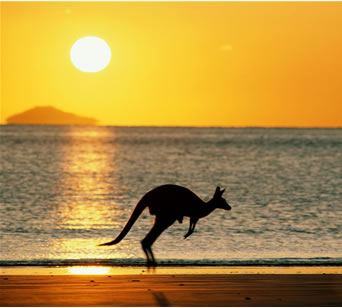
Mr Mjadwesch also challenged Dr Fletcher’s estimates of the number of kangaroos living in the reserves. But the tribunal preferred Dr Fletcher’s evidence over the evidence given by Mr Mjadwesch.
Outside the tribunal, ACT Parks and Conservation Service director Daniel Iglesias said as much of the cull would be completed as possible before a July 31 deadline.
“We originally had an eight week period and now we’ve only got a period of four weeks or so. So we will do our best to do what we can with the time that we have available to us,’’ Mr Iglesias said. Kangaroo culling only takes place in the ACT during the colder months to reduce the chances of younger animals being killed.
Fiona Corke, a former Neighbours star who is president of the Australian Society for Kangaroos, said she was disappointed the cull would go ahead. “We are disappointed that the cull will be proceeding but we are also encouraged by the fact that the tribunal has recognised that number of kangaroos should be and will be reduced,’’ she said.
Ms Corke declined to comment on whether her group would join protest efforts to disrupt the cull. >>
.
[Source: ‘Activists vow to disrupt shooting as roo cull approved by tribunal’, 20130710, by Peter Jean, Chief Assembly Reporter, The Canberra Times, ^http://www.canberratimes.com.au/act-news/activists-vow-to-disrupt-shooting-as-roo-cull-approved-by-tribunal-20130710-2ppeg.html]
.
.
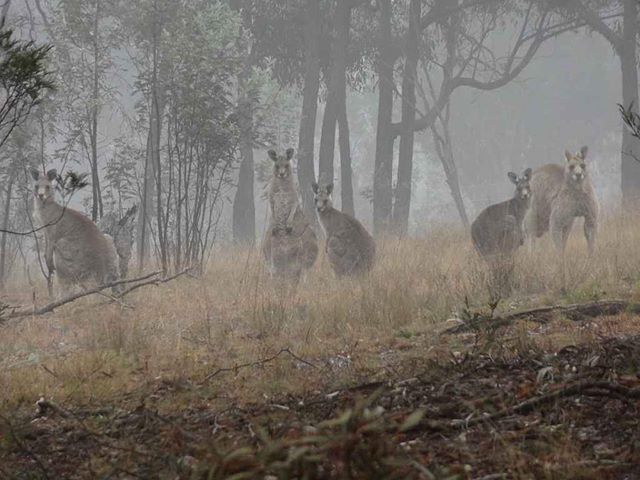 Eastern Grey Kangaroos were around Canberra before Canberra was thought of,
before developers profited from housing sprawl into kangaroo feeding grounds,
before the ACT government fenced them in so they overbred.
Now Katy Gallagher brands kangaroos not Native, but a pest,
just like British colonials treated Aborigines up until the ^1928 Coniston Massacre.
Eastern Grey Kangaroos were around Canberra before Canberra was thought of,
before developers profited from housing sprawl into kangaroo feeding grounds,
before the ACT government fenced them in so they overbred.
Now Katy Gallagher brands kangaroos not Native, but a pest,
just like British colonials treated Aborigines up until the ^1928 Coniston Massacre.
.
<< Known as the “Bush Capital”, Canberra has many nature reserves, but the present Legislative Assembly approved the slaughter – during June 2012 – of 2,000 kangaroos on these reserves.
Although the government-ordered slaughter has now ended for this year, the government fell short of its quota, with ‘only’ 1,154 killed, and has threatened to raise the quota for next season to make up for the shortfall.
However, the joeys aren’t counted in this number – as if they don’t ‘count’ or matter – so we’ll never know how many babies were murdered – by decapitation, bashed in heads – and other brutality – as the officially approved method. >>
.
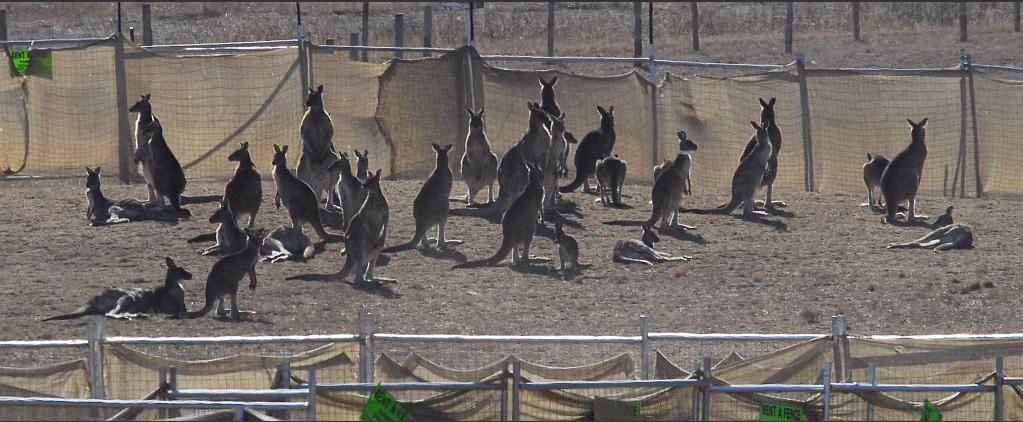
Monday May 19, 2008, government contractors started herding and slaughtering kangaroos on a former naval base in Canberra.
By May 29, 514 kangaroos were dead (including all in this photo).
[Source: Day Drew, Warning: this site contains images of animal suffering that may disturb some viewers.
^http://www.kangaroolives.com/]
.
I have several soul-destroying photos of the killing fields’ burial pits filled up with adult kangaroos and tiny joeys. The photos – including the one (below) – and the following description of events from those in the field were what drove me to start this petition.
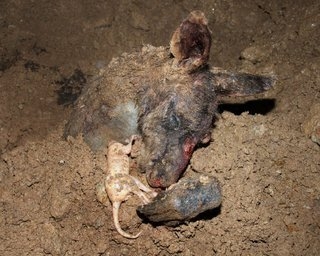
<< “Unearthing the slaughter in Canberra, June 3rd: In the early hours of Sunday morning, activists uncovered a large mass burial pit at the Kama Nature reserve containing an estimated 300 or more slain kangaroo bodies.
Evidence was discovered amidst a slurry of mud and blood, illustrating unethical and illegal practices including throat shots, partially severed joeys and mature kangaroos with smashed heads. Amidst the twisted pile of discarded iconic Australians, a mature buck stands amongst his once proud mob – gunned down by faceless ignorance in Australia’s Capital.” >>
.
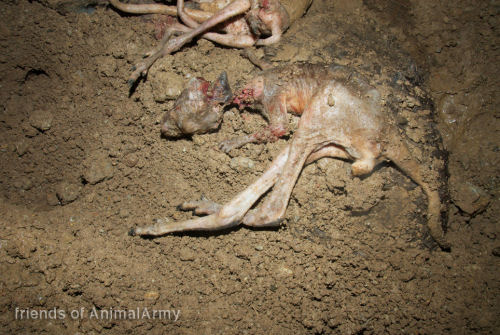
.[Source: ‘Stop the Slaughter of Kangaroos in Canberra’, 2013, a petition by Honour Leigh, ^http://www.change.org/en-AU/petitions/stop-the-slaughter-of-kangaroos-in-canberra]
.
Canberra’s 100 years of ecological slaughter to justify a ‘Bush Capital‘
.

.
2013: Katy Gallagher wants to slaughter 1,455 kangaroos this year in Canberra nature reserves
.
2012: Katy’s Cull included 407 joeys slaughtered
.
2009 – 2012, 3,000 kangaroos of Canberra were slaughered in various so-called ‘Nature Parks’.
.
[Source: ‘ACT kangaroos live another day’, ^http://www.al-act.org/]
.
Katy, wasn’t your 2011 massacre bad enough?
.
<<More than three thousand kangaroos will be shot over the next month as part of the ACT Territory’s annual cull, which starts tomorrow. ACT Parks and Conservation, which oversees the contractors conducting the cull, is this year targeting 3427 kangaroos on six sites in the Canberra Nature Park. The sites that will be closed to the public while the cull is underway are Mulligans Flat Nature Reserve, Goorooyaroo Nature Reserve, Mount Painter Nature Reserve, Callam Brae Nature Reserve, Jerrabomberra West Nature Reserve, Kama Nature Reserve and unleased territory land adjacent to Kama Nature Reserve.
ACT Parks and Conservation Service manager Daniel Iglesias said this morning that kangaroo numbers continued to rise despite the Government’s Kangaroo Management Plan culling program. “The cull of up to 3427 kangaroos is needed to maintain kangaroo populations at appropriate levels to protect the integrity of ecosystems, several of which contain endangered flora and fauna,” he said. “The numbers to be culled have been based on kangaroo counts in each location. “Ensuring the grasslands and woodlands are not overgrazed will protect threatened species and ecosystems, provide habitat for creatures such as ground-feeding birds, prevent excessive soil loss and maintain sustainable numbers of kangaroos.”
Mr Iglesias said the kangaroos would be humanely culled by experienced marksmen. “The cull will be conducted according to a strict Code of Practice that has the endorsement of all relevant authorities including the RSPCA. “Rangers and security staff have been engaged to patrol areas to ensure the safety of the public with warning signs also being installed at all entry points to the reserves,” he said. The ACT Government Vet would conduct spot checks during the program to ensure compliance with the relevant code of practice.>>
.
[Source: Canberra Times, ^http://www.kangaroo-protection-coalition.com/CanberraKangarooKill.html]
.
What about 2012, running out of kangaroo meat pet food?
.
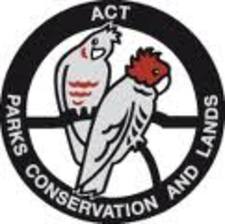 Wildlife Slaughter Sponsor Wildlife Slaughter Sponsor
.
<< More than 2,000 eastern grey kangaroos will be culled across nine reserves across the ACT over the next three weeks.
Nine nature reserves will be closed from Tuesday until June 12 to allow expert shooters to complete the cull. The reserves include Callum Brae, Crace, Goorooyaroo, Jerrabomberra, Kama, Mt Painter, Mulligans Flat, The Pinnacle and Wanniassa Hills.
Daniel Iglesias from Parks and Conservation says the high number of roos is damaging the environment.
“We’re fortunate in the ACT that we have really good quality natural environment so close to where we live,” he said. “So it’s a park service intention to manage kangaroo numbers so that they do not degrade their environment.”
The cull is part of the ACT Government’s Kangaroo Management Plan and will be conducted according to a strict code of practice endorsed by the RSPCA.
“We have gone out to almost all the areas in which we are going to cull and we have taken an estimate of the total numbers,” Mr Iglesias. “So in those nine areas that we are focusing on we’re looking at removing animals which may represent 10 – 15 per cent of the total population.” >>
.
 Wildlife Slaughter Sponsor Wildlife Slaughter Sponsor
.
[Source: ‘Canberra roo cull begins, parks closed’, 20120521, ^http://www.abc.net.au/news/2012-05-21/canberra-roo-cull-begins/4023910]
.
Ed: Sufficient power, means and justification can achieve anything one desires.
Anything!
.
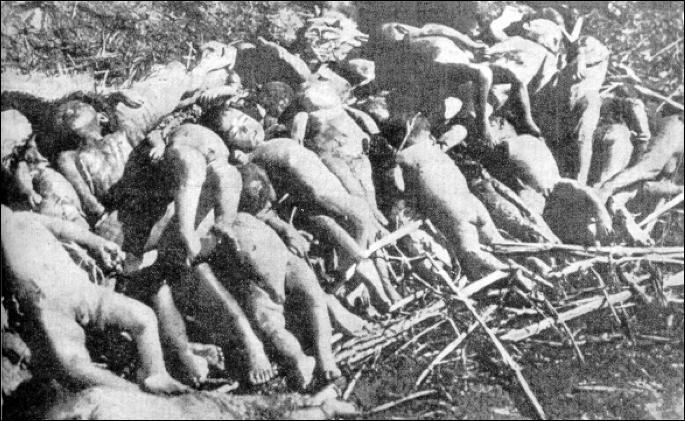 The Nankin Massacre of 300,000 unarmed Chinese men women and children by the Japanese military on December 13, 1937.
Because they were in the way of Japanese plans for economic expansion into Manchuria
It is a territorial thing.
What’s the moral difference Katy Gallagher? The Nankin Massacre of 300,000 unarmed Chinese men women and children by the Japanese military on December 13, 1937.
Because they were in the way of Japanese plans for economic expansion into Manchuria
It is a territorial thing.
What’s the moral difference Katy Gallagher?
.
Saturday, June 22nd, 2013
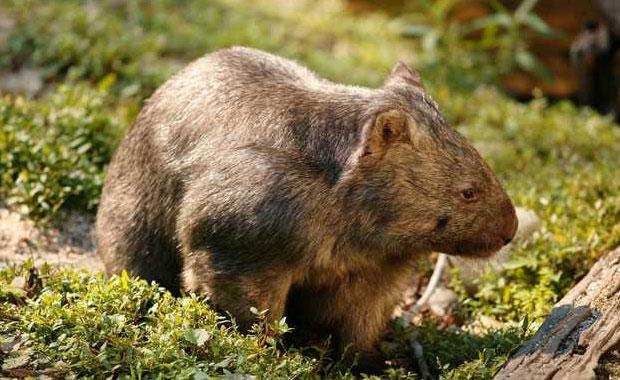 Common Wombat
(Vombatus ursinus)
A legally protected native animal throughout Australia
[Source: Healesville Sanctuary, Victoria, Zoos Victoria,
^http://www.zoo.org.au/healesville/animals/wombat] Common Wombat
(Vombatus ursinus)
A legally protected native animal throughout Australia
[Source: Healesville Sanctuary, Victoria, Zoos Victoria,
^http://www.zoo.org.au/healesville/animals/wombat]
.
June 2013:
.
Tragically, a native Wombat has been deliberately poisoned this month in Mount Wilson in the Blue Mountains, and so the New South Wales National Parks and Wildlife Service (NPWS) is appealing for information from the local community.
Ranger Neil Stone of the NPWS Blue Mountains Region:
“A Wombat was recently found at Mount Wilson village (population 220), suffering from what a local veterinarian thinks was poisoning and sadly the animal had to be euthanized.
“Wombats become unpopular with landholders when they damage fences and infrastructure or trample on gardens. But there are methods, including installing Wombat Gates, that enable Wombats to pass through properties without damaging them.”
.
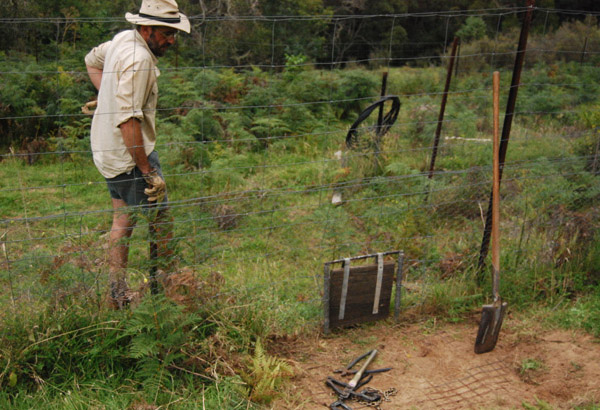 An example of a purpose-built Wombat Gate
If one can afford property at exclusive Mount Wilson with average prices currently $750,000 [^Source]
then one can afford to contribute a few purpose-built Wombat Gates across their property,
constructed by wildlife experts who know what they are doing!
[Photo Source: Rocklily Wildlife Refuge, Taralga, NSW,
^ http://rocklilywombats.com/blog/rocklily-history/] An example of a purpose-built Wombat Gate
If one can afford property at exclusive Mount Wilson with average prices currently $750,000 [^Source]
then one can afford to contribute a few purpose-built Wombat Gates across their property,
constructed by wildlife experts who know what they are doing!
[Photo Source: Rocklily Wildlife Refuge, Taralga, NSW,
^ http://rocklilywombats.com/blog/rocklily-history/]
.
NPWS Ranger Neil Stone:
“Wombats are extremely strong and determined, constructing their burrows (often under homes) to escape from the heat and to hide from predators (typically domestic and feral dogs nowadays). The burrows can be up to 30 metres long which can cause conflict between Wombats and humans.”
“Wombats and all other native animals are protected under the National Parks and Wildlife Act 1974 and Regulations and it is illegal to harm them without a licence. There are fines and possible imprisonment for people found to have intentionally harmed native wildlife.”
.
[Source: ‘Not so divine: Wombat dies in suspected poisoning’, 20130612, Blue Mountains Gazette newspaper (print only), p.15]
.
Wildlife Poisoning is Animal Harm
.
Wombats being mammals are sentient animals, meaning that they feel emotion and pain. An animal is ‘sentient‘ if it is capable of being aware of its surroundings, its relationships with other animals and humans, and of sensations in its own body, including pain, hunger, heat or cold.
Individuals who harm animals including the harming of wildlife such as by poisoning, tend to harbour a personality disorder. Statistically, animal abusers are five times more likely to go on to commit violent crimes against people.
Deviant behaviors like animal abuse generally originate from a traumatic childhood. The American Psychiatric Association considers animal cruelty as one of the diagnostic criteria of conduct disorder.
The fourth edition of the Diagnostic and Statistical Manual of Mental Disorders (DSM) defines conduct disorder as “a repetitive and persistent pattern of behavior in which the basic rights of others or major age appropriate societal norms or rules are violated.” Conduct disorder is found in those who abuse animals and abuse people.
Clinical evidence indicates that animal cruelty is one of the symptoms usually seen at the earliest stages of conduct disorder, often by the age of eight. This information has only recently been included in the DSM so some psychologists, psychiatrists, and social workers are just now becoming aware of it. Many psychological, sociological and criminology studies in recent decades have clearly shown that violent offenders have adolescent histories of serious and repeated animal cruelty.
Director of People for the Ethical Treatment of Animals (PETA) Asia, Jason Baker, has said, “We believe that cruelty to animals is not inherent, but learned. That being said, teaching kindness and respect for animals – in our schools and homes – will foster empathy, the ability to understand what someone else feels.” He added, “Incorporating the simple concepts of kindness and respect into our daily lives and teaching our children to respect and protect even the smallest and most despised among us will help kids value one another.”
The link between animal abuse and interpersonal violence is becoming so well established that many U.S. communities now cross-train social-service and animal-control agencies in how to recognize signs of animal abuse as possible indicators of other abusive behaviors. >>
.
[Source: ‘Animal Cruelty Syndrome’, by Canadians for Animal Welfare Reform, ^http://cfawr.org/animal-abuse.php]
.
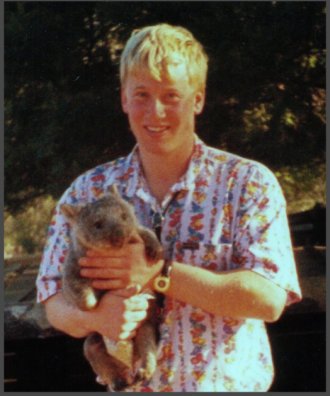 Martin Bryant as a teenager nursing a juvenile Wombat
Bryant reportedly tortured animals as a child.
In 1996, at age 29 Bryant murdered 35 people and injured 21 others
at Port Arthur Tasmania Martin Bryant as a teenager nursing a juvenile Wombat
Bryant reportedly tortured animals as a child.
In 1996, at age 29 Bryant murdered 35 people and injured 21 others
at Port Arthur Tasmania
.
Penalties in NSW for Harming protected Fauna
.
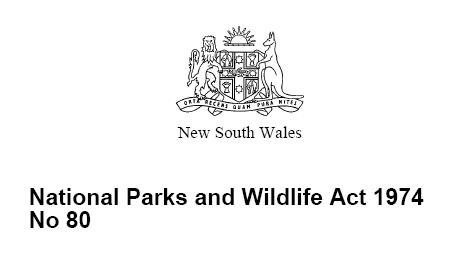
.
Sect 98 ‘Harming protected fauna, other than threatened species, endangered populations or endangered ecological communities’
.
(Ed: i.e. Wombats)
.
(1) In this section, protected fauna does not include threatened interstate fauna, threatened species, endangered populations, endangered ecological communities, or locally unprotected fauna under section 96.
(2) A person shall not:
(a) harm any protected fauna, or (a1) harm for sporting or recreational purposes game birds that are locally unprotected fauna, or
(b) use any substance, animal, firearm, explosive, net, trap, hunting device or instrument or means whatever for the purpose of harming any protected fauna.
.
Maximum penalty:
.
(a) 100 penalty units and, in a case where protected fauna is harmed an additional 10 penalty units in respect of each animal that is harmed, or
(b) imprisonment for 6 months, or both. >>
.
Note: As at 2013, 1 penalty unit in NSW equates to $110. So 100 +10 penalty units incurs a fine of $12,100 per protected Wombat harmed [Calculation: (100 + 10) x $110]
.
[Sources: National Parks and Wildlife Act 1974, No 80, Section 98, (historical version but this section still current), pp 149-150, ^http://www.environment.nsw.gov.au/legislation/NationalParksAndWildlifeAct1974.htm ; ^http://en.wikipedia.org/wiki/Penalty_units]
.
.
.
So who killed the Mt Wilson Wombat?
.
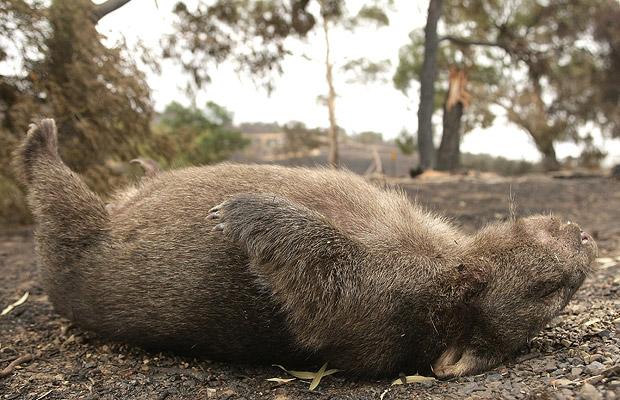 A common Wombat sight
…”Just Roadkill”
A common Wombat sight
…”Just Roadkill”
.
It is likely that Mount Wilson’s Wombat was poisoned by an ignorant and frustrated local landholder. He is one of just a few hundred residents living at remote Mount Wilson village, and probably he is some arrogant newcomer with no respect for the natural environment or its resident wildlife who were there first. It is extremely rare for a female to commit wildlife poisoning.
The perpetrator is likely to be someone holding an Anglicised mindset toward rural property, desiring the exotic deciduous garden and with a phobia towards the natural Australian bush. Whereas the more established residents tend to be respectful towards the special environment in which they live and have become more accommodating towards the place’s resident wildlife.
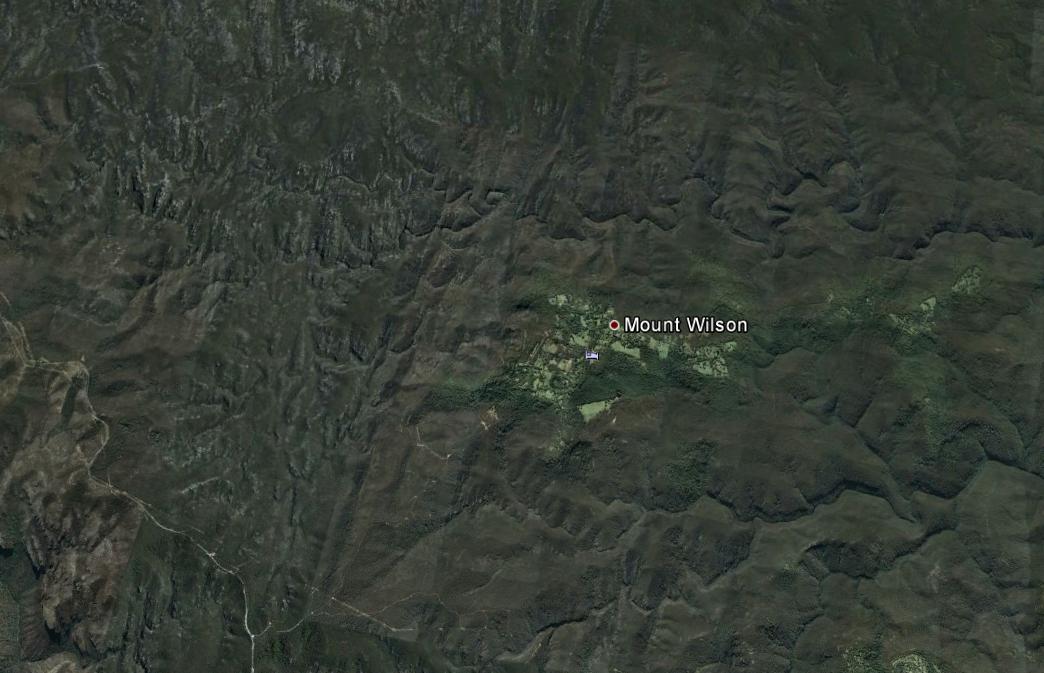 Mount Wilson lies in a remote forested wilderness region of the Blue Mountains
And the native Wombats have lived there thousands of years before
Colonial Deforestation
Housing Development
Anglicised Garden Romanticism
[Source: Google Earth]
(click image to enlarge) Mount Wilson lies in a remote forested wilderness region of the Blue Mountains
And the native Wombats have lived there thousands of years before
Colonial Deforestation
Housing Development
Anglicised Garden Romanticism
[Source: Google Earth]
(click image to enlarge)
.
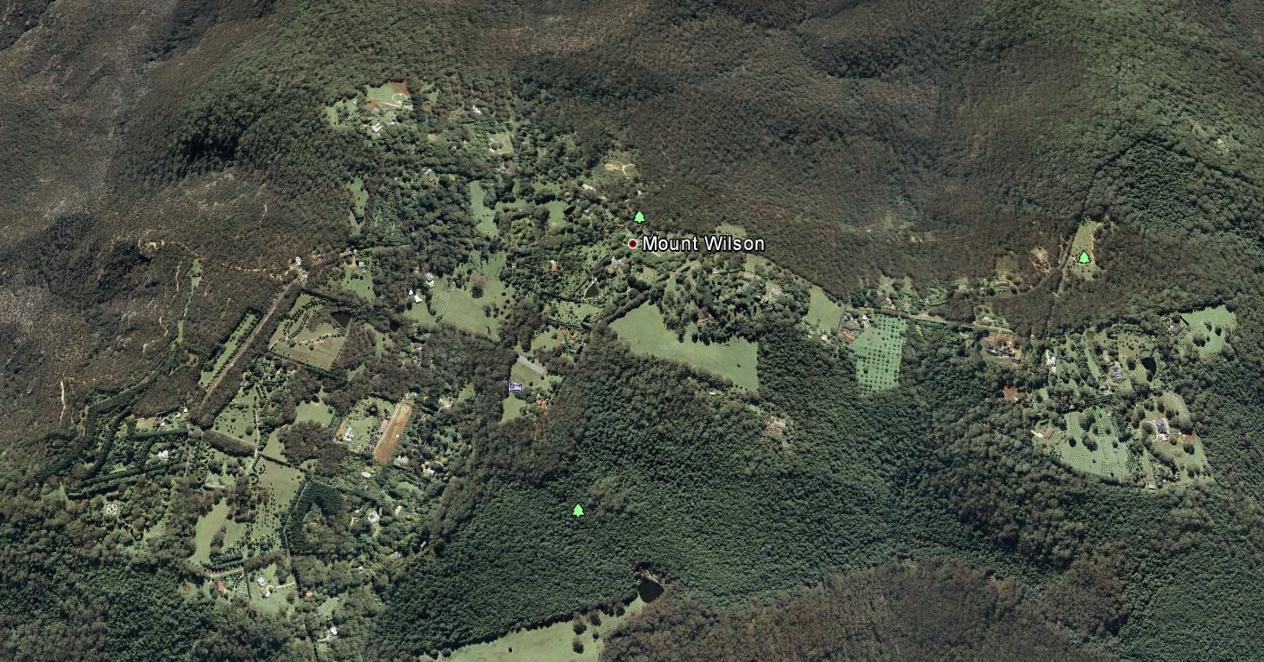 Mount Wilson
Best described as a remote hilltop residential hamlet
Situated on an ancient volcanic hill
Since the 1870s, logged, burned and settled by English colonists
amongst the ‘Wombat Holes’
[Source: Google Earth]
(click image to enlarge)
Mount Wilson
Best described as a remote hilltop residential hamlet
Situated on an ancient volcanic hill
Since the 1870s, logged, burned and settled by English colonists
amongst the ‘Wombat Holes’
[Source: Google Earth]
(click image to enlarge)
.
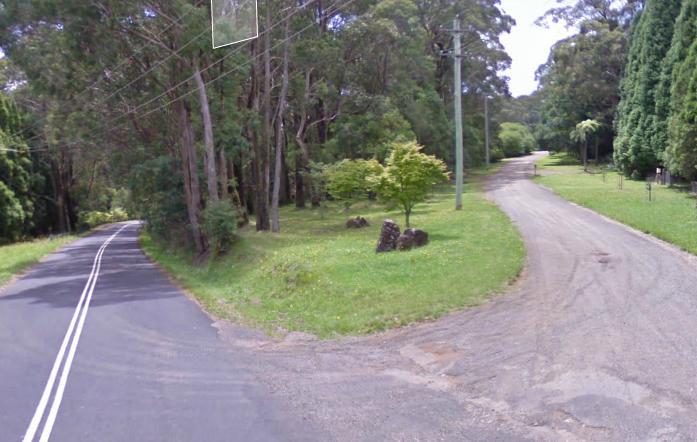 Hillcrest Lane (right), Mount Wilson Hillcrest Lane (right), Mount Wilson
[Source: Google Maps, 2013]
.
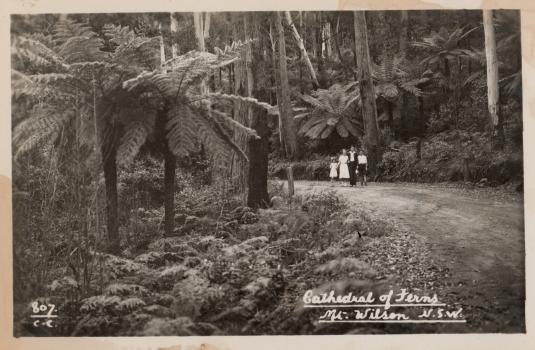 Mount Wilson before the Anglicising
[Source: Mt Wilson/Mt Irvine Historical Society, ^http://www.mtwilson.com.au/]
Mount Wilson before the Anglicising
[Source: Mt Wilson/Mt Irvine Historical Society, ^http://www.mtwilson.com.au/]
.
Consistent with the profile of the typical member of the Game Council NSW, the perpetrator is likely to be a middle-aged or older male Babyboomer approaching 65, having an anthropocentric worldview of Nature, and an evangelistic belief that economic growth and personal wealth accumulation is a right – Wombats being collateral damage in rural housing development.
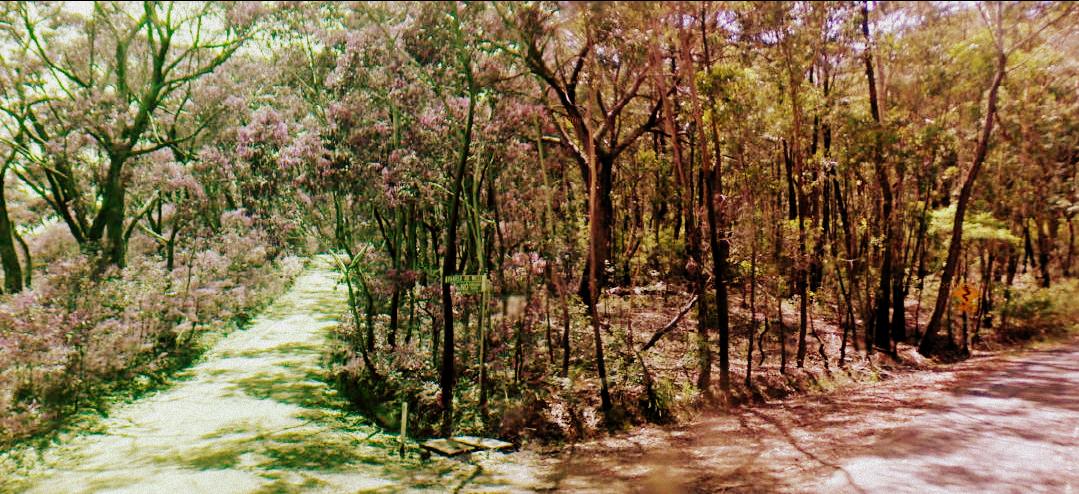 Mount Wilson bushland
Mount Wilson bushland
.
The perpetrator has not yet been confirmed, and anyone with information about this harmful offence is asked to contact the closest NPWS base at the Blue Mountains Heritage Centre in nearby Blackheath.
.
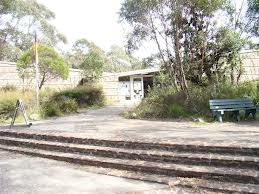 NPWS Blue Mountains Heritage Centre
Located towards the eastern end of Govetts Leap Road
outside the nearby township of Blackheath NPWS Blue Mountains Heritage Centre
Located towards the eastern end of Govetts Leap Road
outside the nearby township of Blackheath
.
.
.
The ‘Common‘ Wombat?
.
The Common Wombat (Vombatus ursinus) is also known as the Coarse-Haired Wombat or Bare-Nosed Wombat. In the case of the Bare-Nosed Wombat, this reference to its nose, distinguishes it from its other two subspecies, the Southern Hairy-Nosed Wombat (Lasiorhinus latifrons) and the endangered Northern Hairy-Nosed Wombat (Lasiorhinus krefftii).
The ‘Common Wombat‘ is a nocturnal marsupial native to south eastern Australia and is found in small sections of southeast tip of Queensland, eastern New South Wales, eastern and southern Victoria, and south-east South Australia. They are common throughout Tasmania and also on Flinders Island in Bass Strait.
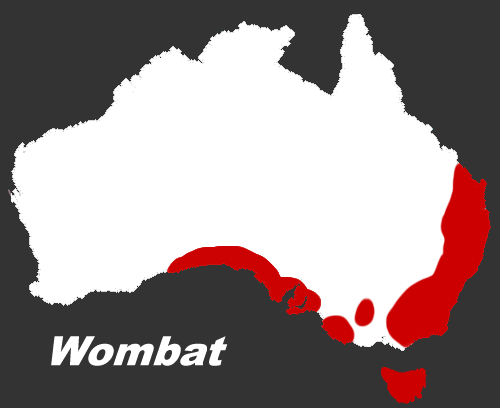
The head of the Common Wombat is more rounded than that of the hairy-nosed subspecies. Their short ears are triangular and slightly rounded. Their nose is large, shiny black and furless. Their fur is coarser, thicker and longer than that of the Hairy-nosed Wombats, better suited to a colder, wetter habitat. Fur colour varies from sandy to brownish black or even grey, sometimes flecked.
.
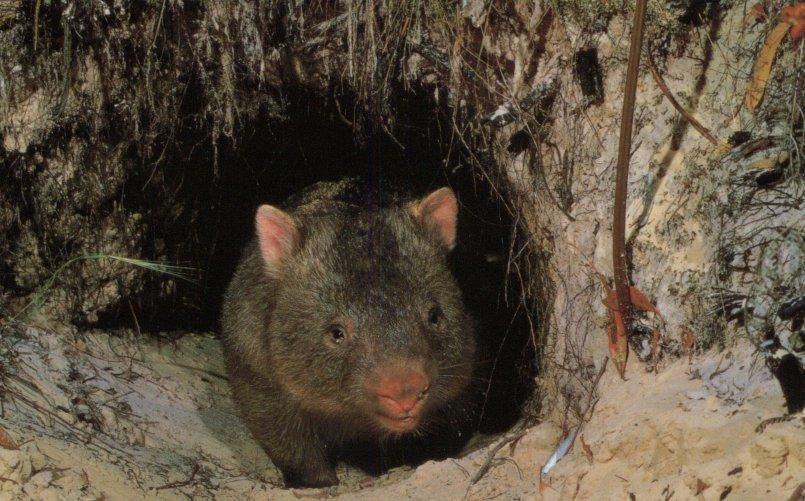 Bare-Nosed Wombat
a more respectful naming than ‘Common’ Bare-Nosed Wombat
a more respectful naming than ‘Common’
.
Wombats have short legs, and the second and third toes of the hind feet are fused, with a double claw used in grooming. Wombats are solid and stocky, with short legs and tail. Their front legs and shoulders are powerful. Their front feet are large, with bear-like long claws. They use their front legs for digging burrows. The dirt is pushed to one side and the Wombat backs out, moving loose dirt with front or back paws. It grows to an average of 98 cm long and up to a healthy weight of 26 kg.
Wombats are stilll classed as ‘least concern’ by the International Union for Conservation of Nature and Natural Resources (on the IUCN ‘red list’). [Ed: So were the Koala and Tasmanian Devil until recently].
At Healesville Sanctuary in Victoria, more than 2,000 sick and injured native animals treated each year including Wombats at its Australian Wildlife Health Centre.
[Source: Healesville Sanctuary, Zoos Victoria, Victorian State Government, ^http://www.zoo.org.au/healesville/animals/wombat]
.
 Situated on Badgers Creek
A place of inspiration to this Editor,
when visited as a child. Situated on Badgers Creek
A place of inspiration to this Editor,
when visited as a child.
.
Although Wombats have been named by European Australians as the ‘Common Wombat‘, their numbers and their existence value does not translate to anyone treating them as commonplace.
Common Wombats were once widespread from south-eastern Queensland, through NSW along the Great Dividing Range and most of Victoria. Now they have a fragmented distribution in NSW, being most abundant in the south-eastern parts of the state. Remaining populations are under continued pressure from land clearing, road mortality, disease and illegal shooting. These pressures may be acute for some local populations.
While the word ‘Wombat’ is derived from the Aboriginal name for the animal, ‘common’ was added at a time when these animals were plentiful and the Australian bush landscape relatively less destroyed by colonial settlement. Wombats were likened to European Badgers by the early colonists.
We prefer the more respectful name, ‘Bare-Nosed Wombat‘.
.
In 2010, university student Nikki Selles, from the School of Natural Sciences at the University of Western Sydney, undertook a field fauna study on Wombats in the Mt Wilson and Mt Irvine area. Due to the behaviour of slow moving, ground-dwelling Wombats being sensibly shy and noctural, Selles used camera-trap data to identify their habitat and distribution in the urban-bush interface.
Results ought to be obtainable from the university.
[Source: Mount Wilson and Community Newsletter, May 2010, ^http://www.mtwilson.com.au/images/stories/MWPA_Newsletters/May_2010.pdf]
.
While the Bare-Nosed Wombat is not yet threatened with extinction, the Northern Hairy-Nosed Wombat is endangered. This is mainly due to overgrazing by sheep and cattle destorying their fragile semi-arid habitat across more central Australia, as well as the culture of broadscale hazard reduction and uncontrolled bushfires.
Mount Wilson also provides vital native habitat for fauna species that are recognised as endangered. These include the Sooty Owl (Tyto tenebricosa), the Eastern Bent Wing Bat (Miniopterus schreibersii oceanensis), the Large eared pied bat (Chalinolobus dwyeri), Little John’s Tree Frog (Litoria littlejohni), and the Eastern False Pipistrelle (Falsistrellus tasmaniensis).
.
Living with Resident Wombats
.
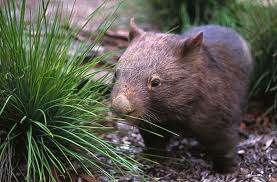 Wombats are locally territorial, like Humans
Try to relocate them, and they will stubbornly resist – even after repeated flood, drought, bushfire and earthquake
Ask any Human who has endured such tempest. Wombats are locally territorial, like Humans
Try to relocate them, and they will stubbornly resist – even after repeated flood, drought, bushfire and earthquake
Ask any Human who has endured such tempest.
.
<<Wombats are an iconic part of the protected fauna of NSW. They are extremely strong and determined animals.
They can build their burrows under Human-introduced houses, driveways and cattle stock routes. This may cause Humans inconvenience and conflict between Wombats and non-Indigenous Humans.
.
But Newcomer Humans need to respect that Wombats were there first.
Who likes Invasion or Displacement?
.
Human-Wombat conflicts can be respectfully resolved and accommodated by wisdom – by learning about the behaviour of Wombats and understanding their habitat needs.
The Bare-Nosed Wombat is the species most frequently found in NSW. They prefer temperate forested areas of the coast, ranges and western slopes. Slopes above creeks and gullies are favoured sites for burrows and they like to feed in grassy clearings, including farm paddocks.
.
Wombat Habitat Needs
.
Wombats construct burrows to escape the heat and hide from predators. They prefer areas where it is easy for them to dig. The burrows can be up to 30 metres long and several metres deep and are usually situated above creeks and gullies and may have multiple entrances. Active burrows are often characterised by fresh cube-shaped droppings and scratch marks as well as freshly dug soil at the burrow entrance. Wombats will often build more than one burrow within their home range of 5 to 25 hectares.
Wombats are mostly solitary animals, but overlapping home ranges can occasionally result in a number of Wombats using the same burrow. Wombats are possessive about their particular feeding grounds and they will mark out these areas by leaving scent trails and droppings. These markings are prominently placed on rocks and logs around the boundaries. If an intruding Wombat encroaches on another’s territory it will be discouraged through a series of snorts and screeches and at times physical aggression.
Breeding occurs year-round with each female typically producing one young. In some areas, however, Wombats are seasonal breeders and may have dependent young in burrows from April to June. Young Wombats take up to 21 months to reach full independence and two years to become sexually mature.
.
Wombat Behaviour
.
Wombats become unpopular with landholders when they damage fences and infrastructure or trample upon gardens. Undetected burrows can be a hazard to livestock as they may trip or fall into burrows and injure themselves.
Many of the problems caused by Wombats can be resolved with some patience and innovation. Landholders willing to share their property with Wombats may find that there are simple solutions to most problems. For example, a post or small strand fence can be used to mark burrows in paddocks or driveways to keep stock away from burrow entrances.
Wombats use the same trails to get to and from their preferred feeding areas. Instead of going around an obstacle, such as a fence, a determined Wombat will try to go through, or under it instead. Installing purpose-built ‘Wombat Gates’ at known Wombat breech points along a fence will allow them to pass through a fence without damaging it. The fence needs to continue to exclude other animals such as wallabies, rabbits and foxes.
Removing the lowest fencing wire (15 cm above ground level) will also allow Wombats to move through an area without damaging the fence. This is a much cheaper option than excluding them completely.
Check first with a Certified National Parks Wildlife Ranger.
.
Excluding wombats from Rural Property
.
It is possible to exclude Wombats from continuing to use a burrow that is under a building but this requires intervention by a Certified National Parks Wildlife Ranger.
.
Increasing Native Vegetation
.
Wombats prefer to burrow in areas of vegetation and rocky debris. Land clearing has forced Wombats to build burrows along creeks and drainage lines where vegetation still exists. Wombats are also often incorrectly blamed for causing erosion, which is more likely due to poor land management practices.
Planting trees and revegetating areas away from creeks can play a vital role in reducing Wombat burrowing activity along creek beds. Retaining existing trees, logs and rocks, and establishing new areas of native vegetation encourages Wombats to construct burrows in less fragile areas and reduces the risk of erosion.
Check first with a Certified National Parks Wildlife Ranger.
.
Trapping or Relocating Wombats Prohibited
.
The trapping and relocation of Wombats is prohibited and attracts heavy fines.
Wombats are territorial animals and if relocated, they are likely to be harassed or even killed by resident Wombats. Wombats are classified as protected fauna under the NSW National Parks and Wildlife Act 1974.
.
Can I bulldoze or infill a Wombat burrow?
.
No! Only inactive Wombat burrows may be destroyed, but each one needs to be first validated by a Certified National Parks Wildlife Ranger.
Bulldozing an active burrow can lead to wombats being buried alive and suffering a slow and painful death. Even if you have located an apparently vacant burrow, you must not fill it in without confirming that it is inactive. Burrow activity can be confirmed by placing sticks across each entrance and checking (every day for at least a week) if these are disturbed.
Remember that if you think you have an inactive burrow, check first with a Certified National Parks Wildlife Ranger.
contact your local National Parks office for expert verification before any action.
.
[Source: NSW Government, ^ http://www.environment.nsw.gov.au/animals/LivingWithWombats.htm#gate]
.
.
.
Further Reading
.
[1] Wombat Gate Design
^http://www.dpiw.tas.gov.au/inter.nsf/Attachments/LBUN-84H7FT/$FILE/Wombat%20gate%20design.pdf
.
[2] Guide to Living with Wombats
[Source: ^ http://www.naturalresources.sa.gov.au/samurraydarlingbasin/plants-animals/native-plants-and-animals/native-animals]
.
[3] National Parks and Wildlife Act (NSW) 1974
^http://www.austlii.edu.au/au/legis/nsw/consol_act/npawa1974247/
.
[4] Wombat Protection Society of Australia
^http://www.wombatprotection.org.au/
.
Why Do Wombats Need Protection?
Lack of Legislative Protection/Enforcement!
<< In Australia native animals are “the property of the Crown”. This means that no-one owns wombats, they can’t be kept as pets and to do anything with them you have to be licensed by government departments.
Government Departments do little to protect or help wombats. Most research and all welfare (rescuing injured wombats, raising the joeys of mothers killed in collisions with vehicles, removing wombats from unsuitable places) is undertaken by voluntary organizations. While penalties exist if someone is found to hurt or kill a wombat, the same government departments charged with wombat care issue permits to farmers to cull wombats. Sadly, there is often no check whether this is necessary, whether it is done humanely or any insistence that alternative options be employed before issuing such permits.
On the other hand although penalties exist for the illegal killing of wombats, such killing occurs every night where on a farms they are shot, buried alive and gassed and on the highways of Australia vehicles indiscriminately drive directly at wombats without penalty. Live joeys left in their dead mother’s pouches die slowly and a lack of public education means few Australians understand how to rescue a joey still living after its mother falls victim to road kill. >>
.
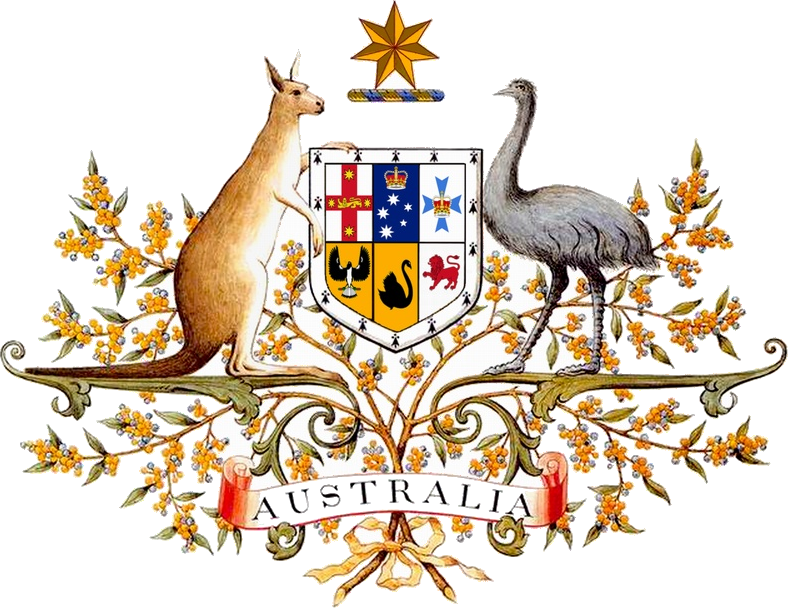 The Crown
Disinterested in protecting Australian wildlife
The kangaroo and emu images are but token symbolism The Crown
Disinterested in protecting Australian wildlife
The kangaroo and emu images are but token symbolism
.
[5] The Wombat Foundation
^http://www.wombatfoundation.com.au/
.
<<The Wombat Foundation is a charitable organisation set up to support activities that aim to bring the Northern Hairy-nosed Wombat back from the brink of extinction.
The Northern Hairy-nosed Wombat is one of the world’s most endangered species – it is more endangered that the Panda.
In the 1980s, there were as few as 35 wombats remaining on the planet – all at Epping Forest National Park in central Queensland. A second population was established at Richard Underwood Nature Refuge in southern Queensland in 2009. At last count, in 2010, there were a total of 176 wombats across the two sites. Since then, the population has continued to grow: in 2012, the combined population at the two sites was estimated at 200 wombats. >>
.
[6] Wombat Awareness Organisation
^http://wombatawareness.com/
.
<<We are a charity established to help save the Southern Hairy-nosed Wombat (Lasiorhinus latifrons) from extinction.
The wombat is an Aussie icon but few people are aware of the peril these gorgeous little animals face: drought, floods, climate change, disease, vehicular incidents and culling – both legal and illegal. It’s not rocket science to see these animals are in trouble but thanks to the work of WAO volunteers, there is hope!
Currently, the wombats are being affected by an unidentified disease outbreak. The visual symptoms are hair loss and emaciation, internally the wombats are anemic and in some cases there is liver damage and heart disease. The direct cause is unknown however it is suspected that due to an increase in weeds there is a decrease in food availability therefore the wombats are forced to eat what they can most of which unfortunately is toxic. >>
.
[7] WIRES
NSW Wildlife Information, Rescue and Education Service Inc.
^http://www.wires.org.au/
.
[8] Rocklily Wildlife Refuge
Taralga, NSW, ^ http://rocklilywombats.com/blog/rocklily-history/
.
<<This website is about Rocklily Wildlife Refuge, and a few other wildlife carers we know in Australia too. Providing a safe place for our native flora and fauna and the various wildlife projects we are undertaking can be an expensive business, so we sell reasonably priced, quality Australian-made gifts and artisan products to raise money for our wildlife projects.
..This website has come about with our move to Rocklily Wildlife Refuge: a safe place for wild native animals just inside the SW border of the Greater Blue Mountains National Park, and within the locked gate of the Sydney Water Catchment. >>
.
[8] Healesville Sanctuary
^http://www.zoo.org.au/healesville
.
<<Healesville Sanctuary, or the Sir Colin MacKenzie Fauna Park, is a zoo specializing in native Australian animals. It is located at Healesville in rural Victoria, Australia (east of Melbourne), and has a rare history of successfully breeding Australia’s native animals.
.
[9] People for the Ethical Treatment of Animals (PETA)
^http://www.petafoundation.org/
.
[10] Voiceless, The Animal Protection Institute
Paddington, New South Wales
^https://www.voiceless.org.au/the-issues/animal-sentience
.
[11] The Cambridge Declaration on Consciousness
.
‘The Cambridge Declaration on Consciousness’, 20120707, by Philip Low, Paper presented at the Francis Crick Memorial Conference on Consciousness in Human and Non-Human Animals, Churchill College, University of Cambridge, England, ^http://fcmconference.org/img/CambridgeDeclarationOnConsciousness.pdf
<< In 2012, an international group of eminent neuroscientists signed The Cambridge Declaration on Consciousness, which confirmed that many animals, including all mammals and birds, possess the “neurological substrates that generate consciousness.” >>
.
.
[12] The Baby Boomers Who Destroyed the World
.
‘The Baby Boomers Who Destroyed the World’, 20110218, by Karlsie, in Subversify, ^http://subversify.com/2011/02/18/the-baby-boomers-who-destroyed-the-world/]
.
[13] Mount Wilson Property Prices
^http://reareports.realestate.com.au/house_prices_growth_rates/nsw/mount_wilson/2786
.
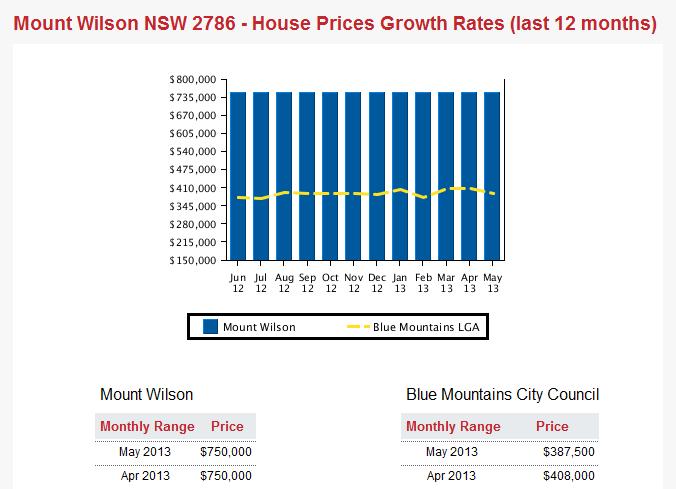
..
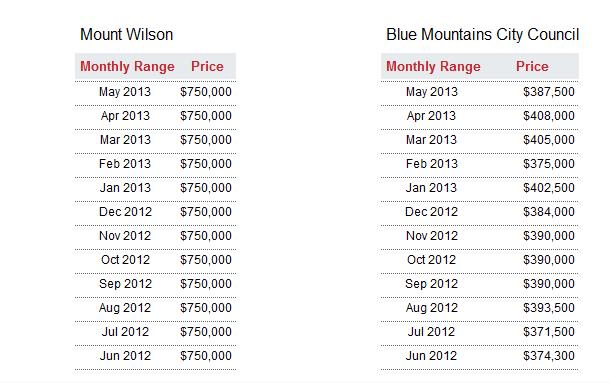 . .
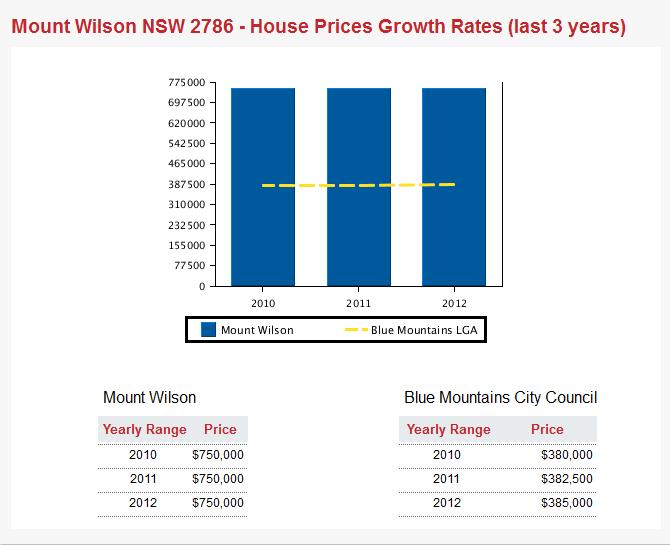 . .
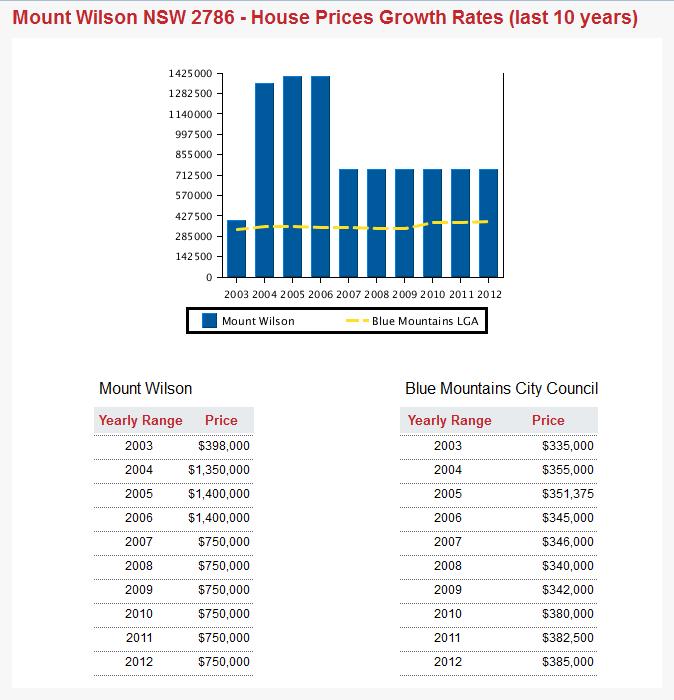 . .
.
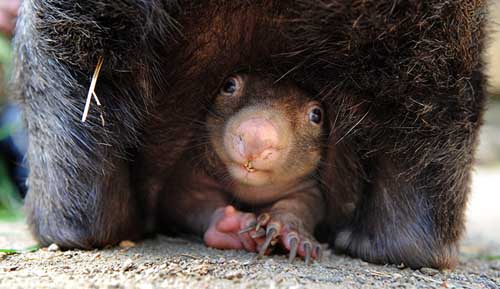
2013 Price?
.
Tags: Anglicising, animal cruelty, Animal Cruelty Syndrome, Animal Harm, Bare-Nosed Wombat, Blue Mountains, Coarse-Haired Wombat, Common Wombat, Living with Wombats, Martin Bryant, Mount Wilson, Mount Wilson Property, Mount Wilson Property Prices, Mount Wilson Real Estate, Mt Wilson, national parks and wildlife act, NSW National Parks and Wildlife Service, sentient, Wombat Gate, Wombat Habitat, wombat poisoned, Wombat Protection
Posted in Blue Mountains (AU), Threats from Development, Threats from Poaching and Poisoning, Wombats | 1 Comment »
Add this post to Del.icio.us - Digg
Saturday, May 4th, 2013
[The following article was written by Tigerquoll and first published on ^CanDoBetter.net under the title ‘Brushtail Possums are a destructive pest in NZ – but is persevering with a backyard fur trade New Zealand’s ethical solution? Comments have been included.]
.
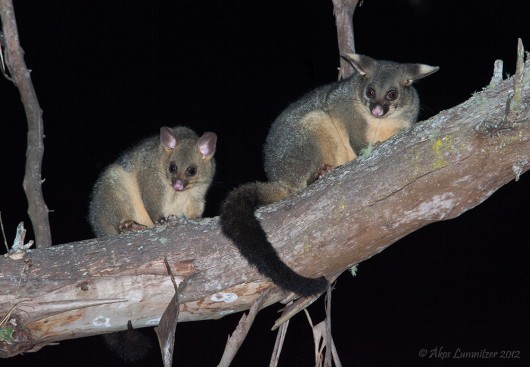 Australia’s native Brushtailed Possum (Trichosurus vulpecula)
Click image to enlarge
Australia’s native Brushtailed Possum (Trichosurus vulpecula)
Click image to enlarge
[Image courtesy of Ákos Lumnitzer, ^http://amatteroflight.com/]
.
Australian Possums were introduced by New Zealanders to New Zealand in 1837
.
Brushtail Possums are native to Australia but a destructive introduced pest in New Zealand.
Yet is ‘Possum Merino‘ New Zealand’s ethical solution to its pest control or really just perpetuating a backward 1837 Fur Trade?
After all, it was New Zealander colonists in 1837 who sailed to Tasmania and to the east coast of Australia to poach Australian Brushtailed Possums and export and introduce them into defenceless New Zealand so as to establish a selfish fur trade. Who else is to blame?
So thanks to colonists, Brushtail Possums have unquestioningly since become a destructive colonising pest to New Zealand, just like so many others –
- Stoats
- Domestic cats
- Chamois
- Deer
- Ferrets
- Goats
- European hedgehogs
- Horses
- House mice
- Rabbits
- Rats
- Himalayan tahrs
- Wallabies (also poached from Australia by colonial New Zealanders)
- Weasels
- and arguably all non-Maori humans.
.
Introduced New Zealanders and their descendants professing natural New Zealand justice need to frankly pull their imposive self-righteous heads in.
.
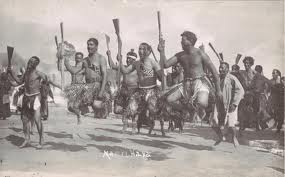 A Maori traditional Haka A Maori traditional Haka
.
Probably the most relevant and credible authority on this centuries old problem of human introduced possums into New Zealand should be New Zealand’s own Department of Conservation (DOC). Yet DOC has no watchdog to vet its possum control policy, to evaluate the ethics of its indiscriminate aerial 1080 poison programmes, its budget decision making, its pest control methods.
New Zealand Department of Conservation is its own master, answerable to no-one. It dictates possum control and culling only on the basis of it deeming it administratively cost effective and efficient. Perhaps this is a leftover culture of Rogernomics applied to lean management of New Zealand’s ecology. On the New Zealand Department of Conservation website, the possum problem in New Zealand is clearly explained. An issue this author accepts as a serious ecological problem facing New Zealand.
Under the heading 3.3 Possum Damage to Native (NZ) Forests, the possum problem in NZ is explained as follows:
“Over the past 50 years, possums have emerged as one of the major threats to the health and wellbeing of forests throughout New Zealand. Many of these impacts are subtle and indirectly affect native birds and insects. Possums cause damage to native forests from the ground level to the canopy where, by concentrating on individual plants of their preferred species, they can kill trees by defoliation over several years. Possums preferentially feed on some of the tall canopy species – such as tawa, northern rata, kohekohe, southern rata, kamahi, pohutukawa and 20 Hall’s totara – while ignoring others. They also prefer some of the smaller trees, such as tree fuchsia and wineberry, along with mistletoe, forest herbs, some ferns, and a number of endangered shrubs.
It is difficult to imagine that possums, which are about the size of a large cat, can kill individual trees that have dominated forest landscapes for centuries before possums were released here. But when the number of possums is combined with the total amount each one eats, their impact on their preferred species is easier to appreciate. The amount of food consumed by an adult possum each night is about 160 gm of digestible dry matter. There are probably tens of millions of possums living in native forests. In total, possums are consuming thousands of tonnes of vegetation each night.
Possum populations have now modified many New Zealand forests. The rate and extent of these changes vary widely between different types of forests. Beech forests are the least affected, but in the vulnerable southern rata-kamahi forests of Westland many valleys have lost between 20% to 50% or more, of their canopy trees. In severe situations, possums have caused the complete collapse of the canopy within 15–20 years of their arrival. Tall forest is then replaced by shrublands.
While the impact of possums is most visible and dramatic when it involves canopy trees, their most pervasive impacts are often less visible. Possums have recently been described as “reluctant folivores”. This means that possums prefer to eat other forest foods than the leaves of trees. Flowers, fruit, leaf buds, fungi and insects are all highly favoured. The consumption of these foods has the largest impact on the healthy functioning of forests and the animals that rely on them. The consequences of possums concentrating on these foods are:
.
Loss of Flowers:
.
- Preventing the formation of seeds
- Removing nectar sources for birds and bats
- Reducing the food supply for many invertebrates
- Nectar loss reducing food supplies for chicks, e.g. kaka, tui.
.
Loss of Fruits:
.
- Reducing food supplies for birds and invertebrates
- Affecting bird breeding condition and nesting success, e.g. kakapo, kereru
- Reducing or eliminating seed dispersal
- Reducing the regenerative capacity of native plants.
.
Loss of New Shoots:
.
- Reducing the ability of plants to overcome leaf loss from weather and seasonal patterns
- Reducing numbers of new leaves, jeopardising plant health.>>
.
New Zealand Department of Conservation also states that “the damage to native forests can be seen all too clearly in many areas. Possums ignore old leaves and select the best new growth. In some areas they have eaten whole canopies of indigenous Rata, Totara, Titoki, Kowhai and Kohekohe.
Possums also compete with New Zealand native birds for habitat and for food such as insects and berries. They also disturb nesting birds, eat their eggs and chicks and may impact on native land snails.
New Zealand Department of Conservation cites examples of natural vegetation damaged by possums at Pirongia Forest Park, and the upper canopy of NZ native forest trees on the slopes of Mt Karioi, south of Raglan.”
So, assuming New Zealand Department of Conservation’s account is correct, the introduced Brushtail possum is a serious pest to New Zealand (NZ) native ecology.
But what to do about it?
.
What should Australia responsibly do – repatriate back its possums?
.
It’s long overdue for the New Zealand Government to get serious about its self-caused possum problem and look to resolve it once and for all for the benefit of the New Zealand ecology and the possums themselves. It needs to look at the root causes.
The possum was introduced to New Zealand by New Zealand profiteering colonists.
 Many New Zealanders conveniently forget:
It is not the possum’s fault it is in New Zealand. Many New Zealanders conveniently forget:
It is not the possum’s fault it is in New Zealand.
.
However, pouring $80 million a year of New Zealand taxpayers money into cruel indiscrimate aerial baiting is not working. If it was the possum problem would be reducing and there would not be a burgeoning possum fur trade.
Instead of perpetuating a 19th Century immoral fur trade, in order to control possums and other introduced pests in New Zealand, one option is to catch and relocate them back to their native home country habitat. This may seem highly expensive and labour intensive and far fetched, but what other option is both humane and effective?
It’s not the possums’ fault. New Zealand colonists introduced them from Australia to New Zealand. The problem is an inherited inter-generational problem caused by New Zealand colonists. It shoud be solved by their descendants, not perpetuated as a fur trade.
Acknowledging the possum in NZ is an introduced pest, the question in this case is whether the possums in New Zealand are being killed humanely and whether this is being effectively monitored by a government watchdog worthy of the public trust?
By killing possums, humans have a moral obligation to do it humanely. Possums like all animals are sentient beings and so feel pain, fear and suffering.
.
New Zealand sprays 1080 poison over its native forests
.
New Zealand Department of Conservation’s official choice of death is aerial baiting with the the literally cheap and very nasty poison ‘1080’ (‘ten-eighty’, or Sodium Monofluroacetate).
New Zealand Department of Conservation’s argues it is humane and safe.
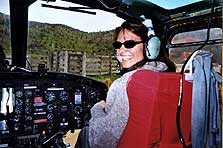 Heading out to drop 1080 poison across NZ forests
(a smiling assassin) Heading out to drop 1080 poison across NZ forests
(a smiling assassin)
.
But The World League for Protection of Animals argues otherwise and offers the following explanation about ‘1080’ poison.
“1080 (sodium monofluroacetate) is a cruel and indiscriminate poison used to ‘remove’ unwanted populations of animals.
Banned in most countries, 1080 is still used liberally throughout Australia to control so-called ‘pest’ species, and reduce ‘browsing damage’ caused by native animals on private land.
1080 poison is a slow killer. When ingested (usually through baited food) the animal suffers a prolonged and horrific death. Herbivores take the longest to die – up to 44 hours, while carnivores can take up to 21 hours before finally succumbing to final effects of the poison. The speed of death is dependent on the rate of the animals metabolism.
.
1080 Poison Causes a Slow & Horrific Death
.
Witnesses to the deaths of herbivorous animals, such as macropods, have reported:
“Affected wallabies were sometimes observed sitting hunched up, with heads held shakily just above the ground. Generally they appeared non-alert and ‘sick’, with shivering or shaking forelimbs and unsteady balance. Most individuals then experience convulsions, falling to the ground and lying on their backs and sides, kicking and making running motions with their hind legs before dying. Many individuals also ejaculated shortly before death, and, with others, exuded a white froth from their nostrils and mouth.”
Carnivorous animals such as dingoes, dogs, foxes, and cats become very agitated, as they tremble, convulse and vomit.
.
Animal symptoms of eating 1080 poison:
.
“…restlessness; increased hyperexcitability; incontinence or diarrhea; excessive salivation; abrupt bouts of vocalization; and finally sudden bursts of violent activity.
All affected animals then fall to the ground in teranic seizure, with hind limbs or all four limbs and sometimes the tail extended rigidly from their arched bodies. At other times the front feet are clasped together, clenched or used to scratch frantically at the cage walls.
This tonic phase is then followed by a clonic phase in which the animals lie and kick or ‘paddle’ with the front legs and sometimes squeal, crawl around and bite at objects. During this phase the tongue and penis may be extruded, their eyes rolled back so that only the whites show and the teeth ground together. Breathing is rapid but laboured, with some animals partly choking on their saliva. Finally such individuals begin to relax, breathing more slowly and shallowly and lying quietly with the hind legs still extended but apparently semiparalysed”.
From the above descriptions, it is without question that 1080 poison inflicts great pain and suffering on affected animals. Aside from the physical pain endured over the many hours before death, the terror, fear and anxiety felt by these animals is unimaginable.”>>
.
.
The main reason why the New Zealand Department of Conservation uses 1080 is simply because it is cheap. Dropping it it indiscriminately by air is efficient and convenient.
Whereas setting caged traps for possums is expensive. Using poisons that act faster that 1080, such as cyanide is also more expensive.
So the New Zealand Department of Conservation’s key justification for its use of 1080 is one of cost.
It also justifies using 1080 because other countries use it for pest control, like Australian & the USA , so implying that 1080 must therefore be ethically acceptable. But New Zealanders should make up their own mind and should recall that both the USA and Australia used Agent Orange in The Vietnam War.
The Department of Conservation also justifies 1080 use because NZ has no natural mammals so the risk to non-target species are nil. But this claim is FACTUALLY INCORRECT!
On 30 July 2008, The Dominion Post reported that after a Department of Conservation aerial drop of 1080, seven kea had died at Fox Glacier from eating the 1080 poison, wiping out almost half a group of the endangered and protected parrot being monitored by the Conservation Department. DOC came up with excuses, but with such an endangered bird with so few kea left on the planet, DOC cannot afford to gamble with the kea’s extinction.
Anti-1080 campaigner Mike Bennett said the kea deaths were the tip of the iceberg. “These are only the monitored ones. If that percentage is extrapolated for the entire population, that doesn’t leave many for the next drop” and has called for a ban on all aerial 1080 drops in alpine areas.
.
New Zealand is not reducing possum numbers, just perpetuating its 1837 Fur Trade
.
New Zealand’s own backyard fur trade has seen a recent resergence since the 1830s when New Zealand hunters first introduced the possum to the wilds of New Zealand. the traditional method of possum slaugher is by trapping. For nearly two centuries the cruel ‘gin trap’ with serrated jaws was used. Although the trapping laws have recently banned gin traps, leg-hold traps remain the method of choice for trappers.
According to the NZ Lifestyle Block website:
“Leg-hold traps such as the ‘Lanes Ace’ or ‘Gin Trap’ have been widely used for possum and rabbit control for many years. The gin trap is more than 10.5 cm across its open jaws, which are serrated, and it is powered by a flat metal spring, so it’s a “size 1½ long spring” trap.
Traps of size 1½ or larger are more likely than the smaller traps to snap shut across the belly or chest of an animal. Although larger traps have been banned, traps of size 1½ can still be used if they are powered by double-coil springs. From January 2011 they will have to be padded, and you can’t modify them yourself to make them padded…
.
Why are these traps cruel?
.
When the gin trap snaps shut on its victim, the teeth bite into the skin and can cause a lot of trauma and no doubt agonizing pain.
All leg-hold traps are indiscriminate about what they catch. If they are set in possum tracks or runs it’s more likely than not that any catch will be a possum, but it might also be a cat… rat, bird or small dog. Large dogs can sometimes pull out of them but they may be injured in the process.
.
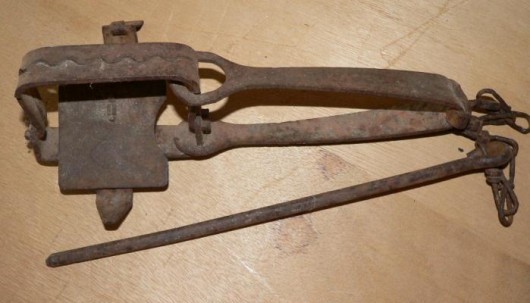 Possum Trappers preferred weapon of choice: the ‘Lanes Ace’ or ‘Gin Trap’
Widely used for possum trappers in New Zealand for many years. Possum Trappers preferred weapon of choice: the ‘Lanes Ace’ or ‘Gin Trap’
Widely used for possum trappers in New Zealand for many years.
.
Icing sugar or flour around traps is sometimes used to attract possums, but if used beneath a trap the animal is likely to be trapped by its snout or head.
.
What are the alternative leg-hold traps?
.
In New Zealand it is still legal to use size 1 leg-hold traps such as the Victor within the restrictions on location and setting described above. It is smaller than the gin trap and doesn’t have serrated jaws.
The ‘Victor No 1‘ can be bought with cushioned inserts that make it more humane. It tends to cause less frequent and less severe injuries than the gin trap and larger leg-hold traps, but it can still cause severe bruising, and trapped animals will sometimes cause themselves severe injuries in their struggle to get free.
Trappers favour the Victor No 1 because it is compact, light and relatively efficient. The changes in the legislation mean that it is likely to become even more popular.
There’s good advice for landowners on the most humane way to use leg-hold traps and their alternatives on the National Possum Control Agencies website (www.npca.org.nz), and not just for possums but for ferrets too.”>>
.
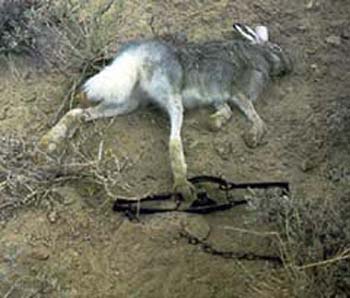 Rabbit caught and dead in Lanes Ace Trap.
The steel jaws of the trap break the rabbit’s leg and it dies of pain and suffering over days.
These are used in New Zealand in the possum fur trade
[Image Source: ^http://www.animalwritings.com/archive/2004_08_01_blog_archive.asp] Rabbit caught and dead in Lanes Ace Trap.
The steel jaws of the trap break the rabbit’s leg and it dies of pain and suffering over days.
These are used in New Zealand in the possum fur trade
[Image Source: ^http://www.animalwritings.com/archive/2004_08_01_blog_archive.asp]
.
Typical traps used in New Zealand for possums are the flat jaw/leg hold’ type such as the ‘Bushmaster‘. While recognised as more humane that the serrated jaw ‘gin trap’, it can still cause suffering to a trapped animal, and of course is indiscriminate.
The Hamilton City Council on the North Island prohibits the use of leg-hold traps such as gin traps in residential areas and within 150 metres of dwellings or places where there are likely to be pets. It instead recommends Cage Traps and Timms Traps for possums and other feral animals.
.
New Zealand’s 1837 Possum Fur Trade now globally profitable!
.
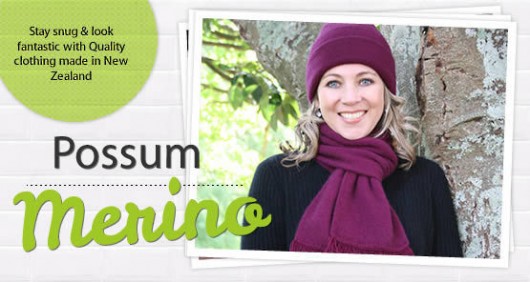
The justification spin:
.
<<…Possums were introduced into New Zealand by the caring, sharing Aussie cousins in the 1870s, to get the fur trade going. [Ed: How do we know it was not New Zealand colonists returning to New Zealand that introduced the possum?] Unfortunately what the possums did is have a fabulous time in the New Zealand climate, and aided by the decline in the fur industry, increased their numbers to over 70 million today.
Possums are a pest in New Zealand. Not only do they manage to consume approximately 21,000 tonnes of vegetation every night, but they are also killing native birds, and generally upsetting the ecological balance. Many native trees, plants and birds, including the Kiwi, are under threat of extinction because the possum is destroying their habitat. A possum will visit the same tree night after night and eat away until the point where the tree cannot recover. It has also now been confirmed that possums will eat both the eggs and chicks of the native Kiwi and Kokako. Where Australian plants have their own defences against the possum, NZ plants do not. The possum has no predator in NZ. Regular culling has been carried out under government supervision since the 1940s and it is estimated to cost around £20 million each year.
Very interestingly, the World Wide Fund for Nature does acknowledge that possums need to be controlled.
Although the culling began in the 1940s, it has only been in the last 30 years that good use was made of the resulting resource.
Kiwis (the human ones!), known for their ability to fix anything with a piece of no. 8 fencing wire, are a bit of an ingenious lot. They’ve managed to turn the pest into an export commodity. Possum meat goes to Asia (have you eaten ‘Kiwi Bear’?!), and the pelt is used for any number of commodities as it has properties that lend itself to both warmth and protection. New Zealand is the only place in the world where possum fur can be harvested.>>
[Source: ^http://www.kiwikate.co.uk/]
.
Ed: The British colonial New Zealander’s cultural inferiority complex with nearby Australia is manifested in a hatred for Australian Possums.
Proud in denial, the fact is that colonial New Zealanders in 1837 chose to sail to Australia to capture the species and voluntarily introduce the Brushtailed Possum to New Zealand.
In 1837, Australian possums didn’t want to go to New Zealand. Colonial Australians at the time probably took no interest in a few New Zealanders taking wildlife for their own gain. Maoris atthe time probably were unaware, had no say then anyway, but would have challenged the introduction had they been duly informed.
Kiwi Kate’s reference to “caring, sharing Aussie cousins” sadly reflects bigotry out of her misinformed upbringing.
.
Use of Feratox (cyanide) Poison?
.
According to the Lifestyle Block website NZ veterinarian Dr Marjorie Orr, BVM&S, PhD, BA and lifestyle farmer on , the most humane method of possum control is to use Feratox capsules, which is an encapsulated cyanide.
The preferred baiting method is to use these in specially designed “bait stations or sachets stapled to trees, baited with peanut butter (possums like it and dogs and birds usually don’t). The pest control companies that put out the poison will usually on request remove the sachets after a few days, and this helps reduce the risk of accidental poisoning of other animals. The poison in the capsules, cyanide, is quickly destroyed on exposure to air. Death is quick and relatively stress-free and there is no risk of secondary poisoning of dogs that scavenge poisoned carcases.”
The test of humane killing must be conditional on the absence of pain and stress caused to the animal and that the killing be very quick.
But the killing of a native animal is wrong, despite it being introduced by humans. It has become a convenient excuse for New Zealanders to kill possums. Possum control by either DOC or the fur trade is not effective and in both cases the chosen methods are inhumane.
.
New Zealand’s possum problem has been allowed to escalate into an immoral industry for profiteers.
The New Zealand Government is responsible for failing to deal with the problem effectively and humanely.
It has perpetuated an immoral fur trade that begun in the 19th Century, and at the same time allowed much irreversible harm to be caused to New Zealand’s fragile ecology.
.
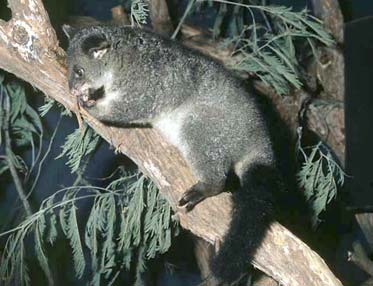 . .
Possum Comments:
.
‘The legacy of human ignorance and delinquency is enormous’
(Vivienne 20091205) :
.
<<Research has begun recently into biocontrol of brushtail possums as the only long-term, cost-effective solution to the possum problem in New Zealand, where possums cause significant damage to native forests, threaten populations of native plants and animals, and infect cattle and deer with bovine tuberculosis.
see the abstract for the CSIRO report
Immunocontraception is a humane means of controlling possums with wide public acceptance.
Although several studies have investigated or modelled its demographic consequences, there have been few studies of the possible effects of the presence of sterile females on local males.
Implications for biological control
Cynanide kills more quickly than 1080, but no less violently. Researchers have called this death humane!
Food is provided in a feeder for a few of days to lull the animals into a false sense of security. Then their trust is betrayed with the food being replaced with encapsulated cyanide pellets. The animals die within metres of the feeding station.
Possums are endearing little animals and what they suffer is horrific! The legacy of human ignorance and delinquency is enormous! Our colonial attitudes continue to haunt us today, with species continually threatened and made extinct by human expansion and self-interests.>>
.
‘Fertility controls the only longterm option for NZ possums’
(Pat, 20091207)
.
<<Fertility controls the only longterm option for control NZ possums, anything else is only a bandaid. We have the technology to do this, it only needs some more research and it could proceed. Its crazy to allow unwanted animals to breed out of control, then cruelly kill them, 1080 or not.
40 years ago we put a man on the moon….and then bought him safely back….and yet we cant humanely solve the NZ possum problem? I dont believe it! The NZ DOC appears to be as incomptent and as useless as our own Australian wildlife bureacracies.>>
.
‘NZ possums’
(Possum lover, 20091208):
.
<<As always- the real pest is the human.
However, I can see from this article that the New Zealand environment would be better off without the Brush Tail Possum. Apart from the cruelty a possum fur industry makes little sense as it would rely on a sustainable population of the animals – and this would mean continued deleterious effects on the environment. Bringing millions of animals back to Australia seems extremely impractical as I think there would be a lack of habitat and how would one round them all up? Human population growth is continually robbing possums of habitat in Australia even though they are very good at sharing with humans.
The poisoning and trapping options are not acceptable at all- and anyway — it seems clear that whatever they are doing in NZ to reduce the population of possums — they are not being effective, anyway !
(As I write this I hear on radio National that a few hundred camels will be shot in central or northern Australia because their numbers have got out of hand and they come close to human settlements looking for water. Who brought the camels to Australia? Who put them to work in opening up the centre of the continent.? Who abandoned them to the wild when they had served their purpose?)
Back to the possums- realistically it seems to me that it’s a choice of either accepting the possums and a changed environment (just as humans changed the ecosystem by extinguishing the moa) or making a concerted effort to humanely totally eradicate the animals from NZ. There is no point in partially reducing the population as more possums will fill the available habitat.
More info on the practicalities of sterilisation would useful. If only there was a measure of the suffering that humans inflict on each other and on other animals. All other suffering on the planet would be dwarfed by this measure.>>
.
‘New Zealand complacent about its wildlife’
(Tigerquoll, 20091208):
.
Yes, I agree the real pest is the human. Yes, I agree the New Zealand environment would be better off without the Australian Brushtail Possum.
To round up and try repatriating the many Brushtail possums in New Zealand back to Australia would be extremely impractical. Do we know the numbers and their geographic concentrations? Assuming the possum are on both islands, can one island be targeted first?
Where would they be repatriate to? Possums are territorial mammals. Even in Australia native wildlife experts claim that it is not possible to relocate possums, which poses problems for both possums already in Australia and for the reintroduced possums. The cost exercise would highlight the extent of the problem and the real costs of New Zealand having neglected a serious pest invasion for nearly two centuries. This reinforces the scale and complexity of introduce pest problems when left ignored.
But what is the alternative that is both ethical and effective?
The sterilisation science sounds encouraging, yet even then ‘immunosterilization’ as it is formally labelled has questions about efficacy of fertility control, the means for delivering antigens. Then there are the potential legal and social concerns that relate to the possible future use of antigens.
But I do recommend this is where the $80 million of New Zealand taxpayers money should be diverted instead of indiscriminate 1080 drops by helicopter. Question is why has the New Zealand Government become so complacent about seeking a humane and effective permanent solution?
Australia’s feral camel problem in central Australia is comparable to New Zealand’s possum problem. I understand they will be shot, which suggests a faster clean kill (so long as the shooter is a trained marksman with appropriate knowledge of camel to effect a single round quick kill, rather than some recreational shooter), but what to do with the carcasses? Is shooting humane and ethical? Is shooting the only answer, or is it just the cheapest and nastiest quick fix coming from some staffers desk? Could these camels not be herded and shipped live back to their native country in the Middle East or North Africa or from wherever their ancestors originated?
Question again is, why has the Australian Government also ignored the feral camel problem for so long to allow it to build to becoming so numerous and widespread?
I am not in favour of New Zealand ignoring its possum problem, because such a defeatist stance would only perpetuate further destruction of New Zealand’s forest ecology and to inevitable local extinctions of native flora and fauna. It would also encourage the perpetuation of New Zealand’s immoral fur trade, which is no different to Canadians commercially clubbing fur seals.
Is the New Zealand Government just as complacent with its Biosecurity? Less than a month ago Queensland cane toad was found in an Australian tourist’s hiking boot in Queenstown on the South Island. All it needed was a mate and it would have been off and breeding. “A MAF biosecurity spokeswoman confirmed the toad arrived last Tuesday but was not spotted.”>>
[SOURCE: ‘Cane toad evades Kiwi airport biosecurity’ , by Tamara McLean, AAP, 20091126. Read More: ‘Cane toad catches ride to Queenstown’, by Will Hine, Fairfax NZ, ^http://www.stuff.co.nz/national/3098565/Cane-toad-catches-ride-to-Queenstown]
.
.
Footnote:
.
It makes it hard for New Zealand’s Department of Conservation to act to properly address New Zealand’s chronic feral possum infestation, when the government sacks 140 of DOC’s staff demanding it cut $8.7 million in operational expenditure…
.
‘DOC cuts 140 jobs’
[Source: ‘DOC cuts 140 jobs’, 20130326, by Michael Daly, Fairfax NZ, ^http://www.stuff.co.nz/national/politics/8471779/DOC-cuts-140-jobs]
.
<<The Department of Conservation (DOC) has announced plans to cut about 140 largely regional management and administration positions. The job losses are part of a reorganisation under which DOC’s existing 11 regional conservancy boundaries will be replaced with six new regions.
DOC director-general Al Morrison says the new structure would maintain DOC’s own conservation delivery work while setting the department up to work more effectively with external partners.
“DOC must adapt if it is going to meet the conservation challenges that New Zealand faces – even if you doubled DOC’s budget tomorrow we would still be going ahead with this proposal.”
DOC would continue to operate out of the same number of offices as now with more than 1200 operational staff, Morrison said. About 118 management and administrative positions would go as a result of the new flatter organisation. A further 22 operational roles would be cut through efficiencies gained by setting up new support hubs for activities such as asset management, inspections and work planning.
The size of the proposal was aimed at ensuring DOC met its $8.7 million savings targets and continued to meet its current delivery work.
.
[Ed: This should pay for John Key’s $7 million funding to Immigration New Zealand to “increase visitor numbers by smoothing processes at the border” ^http://www.nzherald.co.nz/business/news/article.cfm?c_id=3&objectid=10878911].
.
A conservation partnerships group would be set up focused on working with community groups, iwi, local authorities, private landowners and businesses to attract more resources to conservation, Morrison said. Recreational and natural heritage field work would be the responsibility of a conservation services group.
Consultation with staff about the proposals had started and no final decisions would be made until staff feedback had been considered. Any changes would not take effect for some months.
“I acknowledge this will mean a difficult period for many staff and we will be making every effort to ease the impact of these proposals,” Morrison said.
A freeze on hiring new staff had been in place and about 160 positions were filled with temporary staff. “It is simply too early to say what impact these proposals will have on individuals – we will look at all options such as redeployment and relocation to minimise redundancies.”
.
‘GAPING HOLES’
The Green Party earlier today predicted the proposal was to axe 140 jobs.
“With the department already pared to the bone these latest cuts will mean less protection of our special native plants and wildlife,” Green Party conservation spokesperson Eugenie Sage said. “DOC manages more than a third of the land in New Zealand and the argument that volunteers and a few corporate sponsors will fill in the gaping hole these cuts and continued pressure on department spending create is nonsense.
“National is trying to turn DOC into a corporate entity focused on stakeholders and corporate sponsorship at the expense of its key role to to protect and preserve native plants and animals,” Sage said. “This National Government is toxic to the environment and is polluting, digging up and selling our children’s future.”
Prime Minister John Key this morning said the department was over-staffed with middle management and bureaucracy. “What you have seen is, over the good times under a Labour government a big buildup in kind of the middle management and bureaucracy, and in the leaner, harder times where the Government doesn’t have a lot of money to throw around, we don’t have that much money,” he said.
.
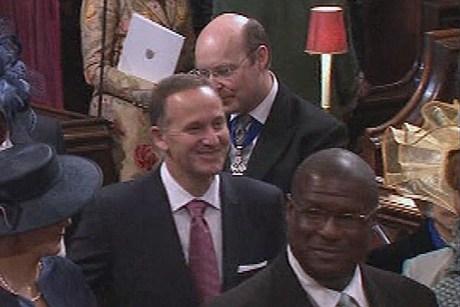 King of Overseas Holidays, John Key,
He flew first class with his wife to attend a foreign royal wedding on 20110429
Here he’s looking resplendent in his bespoke $6,000 suit washed with pounamu.
Total cost of Key Junket which did nothing for New Zealand, NZ$200,000? King of Overseas Holidays, John Key,
He flew first class with his wife to attend a foreign royal wedding on 20110429
Here he’s looking resplendent in his bespoke $6,000 suit washed with pounamu.
Total cost of Key Junket which did nothing for New Zealand, NZ$200,000?
.
.
“Government agencies now needed to be leaner, and more efficient”, Key said. He compared the restructuring to a similar exercise at Telecom, which was expected to axe hundreds of jobs this year.
“If you go and look at what is happening at Telecom at the moment, on a different scale … but no-one is arguing that the chief executive isn’t doing the right thing trying to make sure that organisation is leaner and more efficient,” he said. The Government had a responsibility to taxpayers, he said.
“The management at DOC have a responsibility to ensure that their resources are directed in the right place and that is what you are going to see today,” Key said>>
.
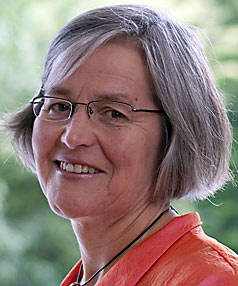 Ms Eugenie Sage
Green Party of Aotearoa representative: Ms Eugenie Sage
Green Party of Aotearoa representative:
.
“National is trying to turn DOC into a corporate entity focused on stakeholders and corporate sponsorship at the expense of its key role to protect and preserve native plants and animals”.
.
Tags: 1080 poison, Brushtailed Possum, Cage Traps, cyanide baiting, Feratox, Gin Trap, KiwiKate, Lanes Ace Trap, New Zealand, New Zealand Department of Conservation, NZ DOC overstaffed, NZ Fur Trade, PM John Key, Possum Damage to Native (NZ) Forests, Possum Merino, World League for Protection of Animals
Posted in Possums and Gliders, Threats from Poaching and Poisoning | Comments Off on Brushtail Possum a NZ backyard Fur Trade
Add this post to Del.icio.us - Digg
Saturday, May 4th, 2013
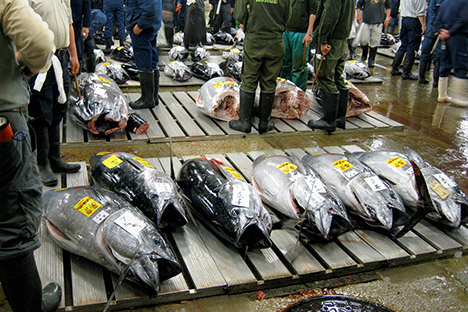 Despite Southern Bluefin Tuna (Thunnus maccoyii) being endangered,
the Australian Government continues its weak policy of appeasing the Japanese – the main poachers and customers of Bluefin Tuna. Despite Southern Bluefin Tuna (Thunnus maccoyii) being endangered,
the Australian Government continues its weak policy of appeasing the Japanese – the main poachers and customers of Bluefin Tuna.
.
<<The Convention on International Trade in Endangered Species of Wild Fauna and Flora is abbreviated ‘CITES’.
The Australian federal Department of the Environment, Water, Heritage and the Arts. Government is a signatory to CITES and since and CITES international trade regulations have been enforceable under Australian law since 27 October 1976. Every signatory to CITES is required to designate a management authority. In Australia this is effectively the Threatened Species Scientific Committee.
On 7 September 2005, Australia’s Threatened Species Scientific Committee concluded that the Southern Bluefin Tuna (SBT)… “continues to be overfished despite the international management arrangements which have been formally in place since 1994.”
“The parental biomass is currently in the order of 3 to 14% of that in 1960 (its unfished size). In addition, BRS has classified SBT as being ‘overfished’ every year since the first BRS fishery status reports were first produced in 1992.
“Stock assessment models have shown a significant historic decline in the biomass of SBT. The mature population of SBT has declined significantly over its last three generations (since the 1980s) and is currently at a very low level.
Therefore, the species is eligible for listing as endangered under Criterion 1.”
The Threatened Species Scientific Committee recommended this to the Australian Government.
Australia’s then Minister for the Environment and Heritage, Senator the Hon Ian Campbell decided against listing the species under the EPBC Act…“as it may weaken Australia’s ability to influence both the management of the global fishing effort and the global conservation of the species.”>>
[Read More: ^http://www.environment.gov.au/biodiversity/threatened/species/southern-bluefin-tuna.html]
.
CITES COP15 draft resolution March 2010 on Bluefin Tuna (Thunnus thynnus)
.
* Fishing capacity is at least double that needed to catch the current legal quota and that recent estimated catches have been four times greater than the maximum catch recommended by scientists to prevent the collapse of the population.
* A 78.4% cut would be needed in the fishing effort by the fleet targeting East Atlantic and Mediterranean Atlantic Bluefin Tuna
* East Atlantic and Mediterranean stock status, fell by 80% in the southern Iberian
Peninsula between 2000 and 2006
* The loss of groups of older fish in the shoals present in the Eastern Atlantic and Mediterranean fishery and the drastic fall in the reproductive biomass, which is currently only 36% of the level that existed at the beginning of the 1970s, are clear symptoms that this population is in imminent danger of collapse.
.
CITES has recommended to:
a) Establish a science-based recovery plan for the East Atlantic and Mediterranean stock
… and to ban industrial fishing – particularly purse seining- during the entire spawning season (May, June and July)
b) Establish immediately an interim suspension of the East Atlantic and Mediterranean bluefin tuna fishery
c) Permit resumption of fishing activities only according to the strict science-based ICCAT population-recovery plan
d) Set up protection zones for spawning grounds in the Mediterranean, including the waters within the Balearic Sea, Central Mediterranean, and Levant Sea, during the spawning season.
.
The Japanese, consumers of 80% of the world’s Bluefin, have rejected the ban and the recommendations, while Australia has not accepted the ban. Australia’s federal minister for the environment etc, Peter Garrett, has refused to join the United States and the European Union in seeking a trade ban.>>
.
March 2010: Peter Garrett rejects bluefin trade ban
.
<<Australia has refused to join the United States and the European Union in seeking a trade ban on imperilled northern bluefin tuna, sparking an outcry from conservation groups.
The fish’s plight is seen as a key example of poor global fisheries management, and its fate a potential precedent for Australian tuna fisheries.
The decision by the Environment Protection Minister, Peter Garrett, to go for trade controls instead of the ban has angered the groups, but Australian tuna fishers said it was a sensible outcome.
Listed as critically endangered by the International Union for Conservation of Nature, the northern, or Atlantic, bluefin has lost 72 per cent to 82 per cent of its original stock under pressure from illegal or unregulated fishing for the sashimi trade.
”What’s driving it over the edge is that about 90 per cent of the catch is unregulated export to Japan,” said Glenn Sant, the global marine program manager for TRAFFIC, the wildlife trade network.
Mr Sant said a study he took part in for the UN Food and Agriculture Organisation showed that northern bluefin met the criteria for an appendix one listing under the Convention on International Trade in Endangered Species.
The appendix one listing, supported by the Obama administration and the EU, would prohibit international trade. It is strongly opposed by Japan and would need a two-thirds majority to be approved.
At the CITES meeting starting today in Qatar, Australia will argue for a lesser appendix two listing that provides instead for more tightly managed trade of the fish.
The Australian Marine Conservation Society said the fears of the domestic bluefin industry should not be allowed to dominate government decision-making.>>
[Source: ‘Garrett rejects bluefin trade ban’, 20100313, by Andrew Darby, Fairfax Media, Hobart, ^http://www.smh.com.au/environment/garrett-rejects-bluefin-trade-ban-20100312-q465.html]
.
CITES failed Bluefin Tuna in 2010
.
<<The triennial meeting of the Convention on International Trade in Endangered Species of Wild Fauna and Flora (CITES) is still underway in Doha, Qatar, this week, but so far news coming out of the conference is a mixed bag. Some trees have been protected, tigers gained a few friends, and a rare salamander got some attention, but all hopes to save the critically endangered bluefin tuna were sunk in a secret ballot that put commerce ahead of science and conservation.
Populations of Atlantic bluefin tuna (Thunnus thynnus) have dropped 97 % since 1960, but the tasty fish remains in high demand in Japan, where sushi bars are willing to pay up to $100,000 or more per fish.
A possible CITES ban on bluefin tuna—supported by the U.S. and 27 European Union nations)—has been in the works for months. Japan, meanwhile, had already announced that it would not comply with such a ban if it were enacted. Unfortunately, the ban failed, and fishing will continue. CITES’s own press release, titled “Governments not ready for trade ban on bluefin tuna,” is surprisingly candid about how this happened:
Japan, Canada and several members States of the Arab league opposed the proposal arguing that regional fisheries management organizations (RFMOs) as ICCAT [the International Commission for the Conservation of Atlantic Tunas] were best placed to tackle the decline of bluefin tuna stocks.
They added that an Appendix I listing [which would ban trade in the species] would not stop the fishing of the species. After a passionate but relatively short debate, the representative of Libya requested to close the deliberations and go for a vote. Iceland called for a secret ballot. The amendment introduced by the European Union and Monaco’s proposal were defeated (20 votes in favor, 68 against, 30 abstentions) in the middle of much confusion about the voting procedures and mixed feelings of satisfaction and frustration from participants.”
Obviously, pro-tuna groups were not happy about this series of events. “It is scandalous that governments did not even get the chance to engage in meaningful debate about the international trade ban proposal for Atlantic bluefin tuna,” said Sergi Tudela, head of fisheries for the WWF Mediterranean Programme Office, in a prepared statement.
Oceana, a conservation group devoted to the health of the oceans, called this “a clear win by short-term economic interest over the long-term health of the ocean and the rebuilding of Atlantic bluefin tuna populations.” And Greenpeace International oceans campaigner Oliver Knowles stated, “The abject failure of governments here at CITES to protect Atlantic bluefin tuna spells disaster for its future and sets the species on a pathway to extinction.”
We’ll be covering more CITES decisions—both good and bad—all week.>>
.
[Source: ‘Sushi-cide: Secret ballot kills hopes for bluefin tuna protections’, by John R. Platt, 20100323, ^http://blogs.scientificamerican.com/extinction-countdown/2010/03/23/sushi-cide-secret-ballot-kills-hopes-for-bluefin-tuna-protections/]
.
Call to Boycott Japanese Cuisine
.
Japanese cuisine includes sashimi, which typically is Bluefin Tuna. Bluefin is the raw fish used in Japanese ‘maguro’, and ‘o-toro’ dishes and in many sushi combinations.
The Australian Government may pasty to the Japanese, but that doesn’t stop ethically driven citizens boycotting Japanese restaurants and sushi shops, which sell raw fish which is typically the critically endangered Bluefin Tuna.
It’s time to send a blunt message to the Japanese that their fettish for Bluefin is backward! Some are labelling the plight of ‘BLUEFIN SUSHICIDE‘.
.
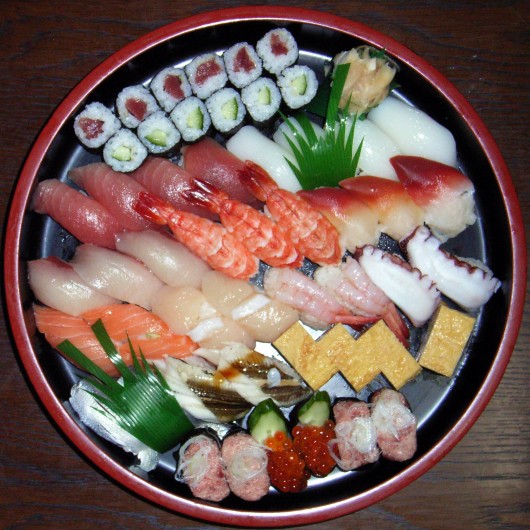 Japanese eating the Endangered into Extinction Japanese eating the Endangered into Extinction
.
Saturday, April 13th, 2013
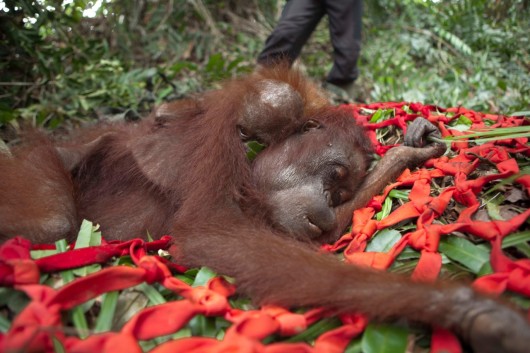 March 2013: she’s almost dead, like her entire species cornered in the wild March 2013: she’s almost dead, like her entire species cornered in the wild
.
<<Footage released 4th April 2013 shows starving orangutans being rescued from an oil palm concession in Borneo after their forest homes were bulldozed by a member of the Roundtable on Sustainable Palm Oil (RSPO), in flagrant violation of the body’s rules.
Conservationists have urged oil palm firm Bumitama Gunajaya Agro (BGA) to cease further clearing immediately amid credible concerns that more of the endangered species are trapped inside the concession and will die if not relocated.
.
[Bumitama is an Indonesian Oil Palm plantation company that cultivates Oil Palm trees and produces crude palm oil (CPO). It was established in 1996 by the Harita Group through its first acquisition of land bank in Central Kalimantan. In 2007, IOI Corporation bought a 33% stake in PT Bumitama Gunajaya Agro.
As of March 2012, Bumitama controls over 190,000 hectares of land bank and has planted 133,000 hectares of Oil Palm trees, mostly in Central and West Kalimantan. Bumitama owns 6 CPO mills (5 in Kalimantan and 1 in Riao), which produces more than 450,000 tons of CPO a year. The main buyers of their CPO include Wilmar, Sinar Mas, and Musim Mas. ]
 Dato’ Lee Yeow Chor
Group Executive Director, Dato’ Lee Yeow Chor
Group Executive Director,
IOI Group of Companies
.
According to RSPO statutes BGA should have carried out High Conservation Value assessments prior to clearing in the concession, setting aside areas that are home to the endangered species.
However, International Animal Rescue Indonesia (IAR Indonesia) and government conservation staff have already rescued four orangutans, including a pregnant adult and a baby, from the concession in Ketapang Regency, West Kalimantan. Other individuals remain at risk if BGA continues to ignore RSPO rules.
Adi Irawan, Program Director of IAR Indonesia Foundation in Ketapang, said:
“We know that there are more orangutans isolated in small patches of forest in this plantation along with other protected wildlife such as proboscis monkeys. All the animals in this plantation are under threat and therefore this company should stop all land clearing immediately, carry out habitat assessments and develop strategies to protect all the endangered wildlife in their estate”.
The concession is operated by BGA subsidiary PT Ladang Sawit Mas (LSM) in a forest buffer next to Gunung Palung National Park, an area that hosts one of the largest populations of Central Bornean orangutan (Pongo pygmaeus wurmbii) in West Kalimantan.
The footage released today shows IAR Indonesia’s Orangutan Rescue Team and the Regency Agency for Natural Resources Conservation (BKSDA) rescuing the orangutans from areas cleared by LSM, to move them to areas with sufficient food for their survival.
Karmele Llano Sanchez, Executive Director of IAR Indonesia Foundation, said:
“We were appalled to see the condition of these rescued orangutans. All of them had gone through long periods of starvation before we rescued them, as the area where they were found, since the company had cleared most of the forest, was too small to provide them with enough food. One of the rescued orangutans had lost her baby, probably killed before the rescue team arrived. More orangutans could die if this company does not take immediate action”.
According to Indonesian Law Act Number 5 year 1990 concerning the Conservation of Living Resources and their Ecosystems the killing of orangutans or other protected wildlife is prohibited and can be severely punished.>>
.
View Footage (click image):.
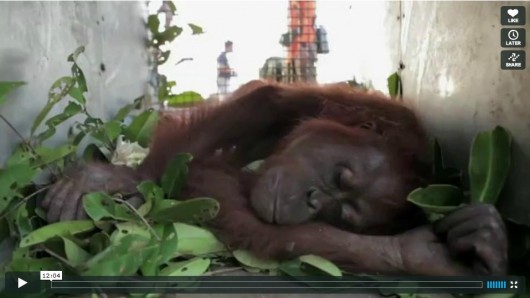 . .
Notes:
.
1. The Environmental Investigation Agency (EIA) is a UK-based Non Governmental Organisation and charitable trust (registered charity number 1145359) that investigates and campaigns against a wide range of environmental crimes, including:
- illegal wildlife trade
- illegal logging
- hazardous waste
- trade in climate and ozone-altering chemicals.
.
2. RSPO Criterion 7.3 dictates that new plantings since November 2005 cannot replace any areas required to maintain or enhance one or more High Conservation Value. This includes “Forest areas containing globally, regionally or nationally significant concentrations of biodiversity values (e.g. endemism, endangered species).”
• To view the footage of the rescue go to ^https://vimeo.com/63254306
• For further photos of the rescued orangutans please contact Tom Johnson at tomaszjohnson@eia-international.org
• Interviews are available on request: please contact Karmele Llano Sanchez (IARI) at karmele@internationalanimalrescue.org or Tom Johnson (EIA) at tomaszjohnson@eia-international.org
• Caption for attached picture: An adult female orangutan who was rescued with her baby by IAR Indonesia in Ketapang, March 2013.
.
[Source: ‘Conservationists urge RSPO member to cease rainforest destruction after starving orangutans rescued from concession’, 20130404, Environmental Investigation Agency on behalf of International Animal Rescue, West Kalimantan (Borneo) Indonesia]
.
HSBC loans $135 million to Bumitama Gunajaya Agro (BGA) Group
.
 . .
<<DBS Indonesia and HSBC (Hongkong and Shanghai Banking Corporation) together with its syndication banks have completed the final process of Syndicated Term Loan Facility for Bumitama Gunajaya Agro (BGA) Group. Due to the oversubscribed participation, the final loan amount provided for the facility has been upsized to USD 135 million from the original amount of USD 110 million.>>
[Source: ^http://www.hsbc.co.id/1/2/misc/media-release/21-oct-10]
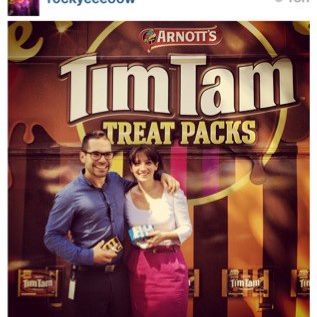 Arnott’s Tim Tam, proudly killing Orangutans
(it is one of Australia’s largest selling products that includes Palm Oil in its manufacture) Arnott’s Tim Tam, proudly killing Orangutans
(it is one of Australia’s largest selling products that includes Palm Oil in its manufacture)
.
<<Palm oil plantations are now the leading cause of rainforest destruction in Malaysia and Indonesia. In Southeast Asia alone the equivalent of 300 football fields are deforested every hour. At the current rate, experts believe Orang-utans will be extinct in the wild by 2013 (this year).
Palm oil and its derivatives are present in 50% of all packaged foods on our shelves. While 50% of products in Australian supermarkets contain Palm Oil, it is nearly impossible for consumers to be able to make an informed choice about which products to purchase. This is because under current food labelling laws, Palm Oil can be legally labelled as ‘Vegetable Oil’.
Australia’s current food regulations don’t require this truth in labelling.>>
.
[Source: ‘Food Labelling, ^http://www.nickxenophon.com.au/food-labelling]
.
.
Products blatantly continuing to include crude Palm Oil
.
Aldi Supermarkets
-Damora snack foods
-Belmont Biscuit co.
-GoldenVale cereals
-Dominion products
-Choceur chocolates
-Bramwells
-Sprinters chips
-Brookdale
-Milfina ice-cream
.
Arnott’s Biscuits
-Shapes (AP)
-Shapes Sensations (AP)
-Tim-Tams (AP)
-Wagon Wheels
-Mint Slice biscuit
-Royals
-Classic assorted
-Venetian
-Lemon Crisp
-Raspberry shortcake
-Arnott’s cookies
-Tiny Teddies
-Jatz Clix biscuits (savoury)
.
Coles Supermarkets (Coles brand range)
-“You’ll Love Coles” range (ice-cream, garlic bread, milk chocolate etc.)
-$mart Buy
-Coles Pastries: Donuts, Biscuits, Cakes, Muffins & Scrolls (AP)
.
Colgate-Palmolive
-Shampoos (AP)
-Conditioners (AP)
-Body wash (AP)
-Soaps (AP)
-Liquid hand-soap (AP)
-Shower gel (AP)
.
Colgate
-Toothpastes (AP)
-Mouthwash
-Shaving cream
.
Fonterra dairy products
-Dairy Milk
Anchor (Fonterra brand)
-Blue top milk
-Cheese singles
-Butter
Mainland cheeses (Fonterra brand)
-Edam cheese
-Colby cheese
-Tasty cheese
-Mild cheese
-Special reserve cheese range (AP)
.
Tip Top ice-creams (Fonterra brand)
-Joy Bar
-Soft serve
-Ice-creams in tub (AP)
-Ice-creams on cone (AP)
-Ice-creams on stick (AP)
.
General Mills
-Old El Paso tacos, dips, salsas & tortillas (AP)
-Betty Crocker products (AP)
-Cheerios breakfast cereal
-Nature Valley granola bars
-Fruit roll-ups
-Latina Pasta (AP)
.
Olay (owned by General Mills)
-Most cosmetics
.
Kraft
-Easy Mac
-Deluxe macaroni and cheese
-Peanut Butter
-Velveeta
-Cool Whip cream
.
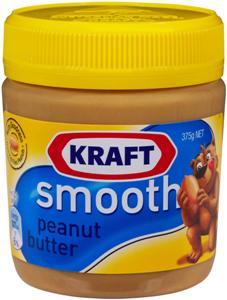
.
Nabisco (owned by Kraft)
-Oreos (AP)
-Ritz Crackers
-Chips Ahoy! (biscuits)
-Wheat Thins
.
Heinz
.
-Beans
-Spaghetti
-Sauces & dressings
-Soups (AP)
-Frozen meals
-Desserts (AP)
-Wattie’s canned snack foods (AP)
-Weight watchers products
.
 . .
Mars Incorporated
.

.
-M&Ms
-Snickers
-Mars Bars
-Milky Way
-Twix
-Bounty
-Maltesers
-Doublemint
-Dove
.
Wrigley’s (owned by Mars)
-5 gum (AP)
-Extra gum (AP)
-Juicy Fruit gum (AP)
-Starburst lollies
-Skittles lollies
-Hubba Bubba bubble gum (AP)
-P.K. chewing gum (AP)
.
Mars Petcare
-Pedigree
-My Dog
-Dine
-Kitekat
-Optimum
-Schmakos
-Advance
-Whiskas
-Royal Canin
.
Sara-Lee
-Bavarians
-Cakes & cheesecakes (AP)
-Chocolate Pies & Fruit Pies
-Croissants & Danishes (AP)
-Crumbles & Puddings
-Ice Creams (AP)
-Lasagna
-Quiches (AP)
.
Snack Brands Australia
-Cheezels
-Samboy chips (AP)
-CC’s corn chips
-Thins chips (AP)
-French Fries
-Chickadees
-Colvan chips
.
Uncle Tobys
.
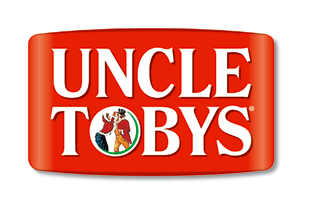 . .
-Fruit Breaks bars (AP)
-Chewy bars (AP)
-Bodywise bars
-Le Snak
-Roll Ups
.
‘AP’ = All products. Palm oil is found in all products or flavours of this specific brand. Example – palm oil is found in all flavours of Arnott’s Shapes: Plain, Chicken, Pizza, BBQ etc.
[Source: ^http://www.saynotopalmoil.com/]
.
“In 2008 Food Standards Australia and New Zealand (FSANZ) rejected an application for the compulsory labelling of Palm Oil, arguing that they have no legal capacity to hear the case.”
[Source: ^http://www.palmoilaction.org.au/shopping-guide.html]
.
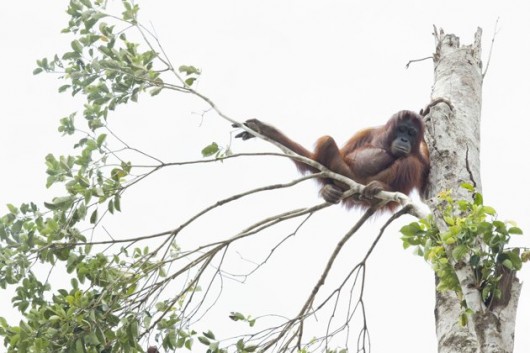 An adult orangutan looks down from its treetop home as the forest in Ketapang, Borneo, is bulldozed (Caters)
Source: ^http://uk.news.yahoo.com/orangutan-rescue-borneo–primates-deforestation-palm-oil-ketapang-mother-and-baby-104041487.html#tZX7oWc] An adult orangutan looks down from its treetop home as the forest in Ketapang, Borneo, is bulldozed (Caters)
Source: ^http://uk.news.yahoo.com/orangutan-rescue-borneo–primates-deforestation-palm-oil-ketapang-mother-and-baby-104041487.html#tZX7oWc]
.
Food Standards Australia New Zealand Board
.
Under the FSANZ Act, the FSANZ Board is selected by the Australian Minister for Health and Ageing in consultation with the Legislative and Governance Forum on Food Regulation and must include qualified people from all walks of life.
.
[Source: ^http://www.foodstandards.gov.au/scienceandeducation/aboutfsanz/theboard/, April 2013]
.
 |
|
Ms Philippa Smith AM [s.116(1)(a)]
Ms Philippa Smith, AM was appointed Chair of the FSANZ Board in July 2008. Ms Smith is a former Commonwealth Ombudsman, CEO of the Association of Superannuation Funds of Australia and the inaugural Chair of the Consumer’s Health Forum. She has developed strong strategic skills and extensive experience in ensuring effective accountability and governance structures across a number of portfolios. |
 |
|
Mr Steve McCutcheon (Chief Executive Officer) [s.116(1)(b)]
Mr McCutcheon, who holds a Bachelor of Economics degree and has undertaken further studies in public law and public policy, was appointed CEO of FSANZ in October 2007. Before his appointment, Mr McCutcheon held a number of senior executive positions in the Commonwealth Department of Agriculture, Fisheries and Forestry. During that time, he led the team that developed the new food regulatory framework for Australia and New Zealand under the auspices of the Council of Australian Governments. Mr McCutcheon also led the Australian delegation to annual sessions of the Codex Alimentarius Commission. |
 |
|
Dr Michele Allan [s.116(1)(f)]
Dr Michele Allan has strong leadership experience across many facets of the food industry. Her areas of expertise include manufacturing strategy, organisational strategy, risk and insurance leadership, food safety systems implementation, food packaging innovation and commercialisation. Dr Allan has held senior executive positions with Amcor Limited, Bonlac Foods, Bioinformatics Centre of Excellence Tasmania, Kraft Foods and ICI; and has also held board positions within both the private and public sectors. |
 |
|
Mr Peter Boyden [s.116(1)(g)]
Mr Peter Boyden is an internationally experienced CEO with extensive general management and marketing experience gained in consumer foods businesses in Australia, the United Kingdom, the Netherlands and Greece. Mr Boyden has been the Managing Director and regional Board member of the Unilever Australasian foods business and a Board member of the Australian Food and Grocery Council. His areas of responsibility have included the management of consumer marketing, product and packaging development, food production and general management, where he has focused on strategy development and portfolio management. |
 |
|
Professor Stephen Corbett [s.116(1)(f)]
Professor Stephen Corbett has had more than 20 years of experience as a public and environmental health physician, with qualifications in public health and medicine. His interests include environmental health risk assessment and management, regulatory policy and practice, and chronic disease prevention. Professor Corbett’s experience includes holding senior executive positions in NSW Health-Public Health; being Conjoint Associate Professor at the School of Public Health, University of Sydney and Western Clinical School, Westmead Hospital; and being Associate Editor on the journal Evolution, Medicine and Public Health. |
 |
|
Ms Jenni Mack [s.116(1)(d)]
Ms Jenni Mack has worked in consumer affairs since 1993 when she was Executive Director of the Australian Federation of Consumer Organisations. Her work has spanned food, chemicals, telecommunications, energy and financial services policy incorporating areas such as industry self-regulatory and co-regulatory practices, professional standards and codes of practice. Ms Mack has worked closely with regulators and government agencies on good regulatory science, community education, licensing, best practice enforcement and compliance schemes, and community and social research projects. |
 |
|
Dr Andrew McKenzie QSO [s.116(1)(c)]
Dr Andrew McKenzie is qualified as a veterinarian with post graduate qualifications in veterinary public health and has a background working for the New Zealand Ministry of Agriculture and Fisheries with a focus on the meat, seafood and other food industries. In 2002, Dr McKenzie set up the New Zealand Food Safety Authority and led it until his retirement in June 2010. He has extensive experience in domestic food safety policy and standards, as well as international food safety and trade standards at the bilateral and multilateral level. Dr McKenzie has a continuing interest in management and governance, as well as contemporary regulatory approaches to food safety/quality and trade, particularly around standard-setting. |
 |
|
Dr James (Gardner) Murray AO PSM [s.116(1)(f)]
Gardner Murray has veterinary medicine, surgery and management qualifications. Through his work in high level government positions and via his company—Gardner Murray Pty Ltd., Dr Murray has contributed to national and international developments in food safety, animal health, ‘One Health’ (collaboration between animal, human and environmental scientists and related disciplines to achieve optimal health), biosecurity, market access, emergency management, animal welfare, policy development and strategic planning. He has held and holds numerous high level Board, Commission and Committee positions at the national and international levels. |

|
|
Mr Tony Nowell CNZM [s.116(1A)]
Mr Tony Nowell has had extensive senior executive experience across various industries (including food) both internationally and within New Zealand. This has included holding positions such as CEO of Zespri International; Managing Director of Griffin’s Foods; Regional Vice President of Sara Lee Asia; Zone Manager for Sara Lee Indonesia, Philippines and Thailand; Managing Director of Sara Lee Indonesia; Managing Director of L’Oreal Indonesia; and Operations Manager of L’Oreal New Zealand. Mr Nowell’s other roles and responsibilities have included being the former Chair of the New Zealand Packaging Accord Governing Board and the New Zealand Government Food and Beverage Taskforce; and include Chairmanship of the New Zealand Forest Research Institute and Wellington Drive Technologies, as well as directorships at New Zealand Food Innovation Auckland and the Export Advisory Board of Business New Zealand. Mr Nowell has represented New Zealand as a member of the APEC Business Advisory Council since 2007. |
 |
|
Dr David Roberts [s.116(1)(g)]
Dr David Roberts is a food and nutrition Consultant with extensive experience in health and science. He has expertise in public health, food science, food allergy, human nutrition, food safety, food industry, food processing/retail, government and regulation. Dr Roberts was the Deputy CEO and scientific and technical Director of the Australian Food and Grocery Council for 5 years until October 2007. Prior to that, he had held the Foundation Chair in Nutrition and Dietetics (established 1991) at the University of Newcastle for 10 years. Dr Roberts was at Sydney University for 12 years teaching and researching in nutritional biochemistry. He is a former Chair of the Federation of Australasian Nutrition Organisations, former President of the Nutrition Society of Australia (3 years), former Chair of the NSW Branch of AIFST (1 year), former Chair of the inaugural Complementary Medicines Evaluation Committee of the Therapeutic Goods Administration (4 years) and former member of the editorial board of the British nutrition foundation (10 years+). |
 |
|
Mr Neil Walker JP [s.116(1)(ca)]
Mr Neil Walker is a food scientist with 35 years of experience in the dairy industry in New Zealand. He is a fellow of both the Institute of Chemistry and the New Zealand Institute of Food Science and Technology (NZIFST); and was the Dairy Chair of the NZIFST. He has had experience as Chair, director, trustee and committee member in relation to public councils and authorities; private trusts; companies and organisations; and national, community, charitable and family entities. |
Tags: Bumitama Gunajaya Agro, Environmental Investigation Agency, Food Standards Australia and New Zealand, FSANZ, Gunung Palung National Park, International Animal Rescue Indonesia, orang-utan, orang-utan extinction, palm oil, palm oil plantations, Roundtable on Sustainable Palm Oil
Posted in Orang-utans, Threats from Deforestation, Threats from Farming | No Comments »
Add this post to Del.icio.us - Digg
Tuesday, March 12th, 2013
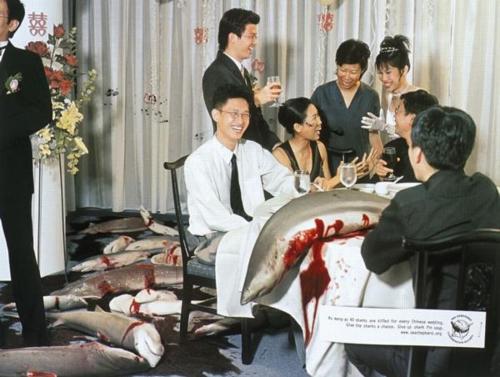 Chinese Shark Fin Soup is the barbaric dish of backward Chinese following a primitive custom from the ancient Ming Dynasty.
Many Chinese eat Shark Fin Soup at weddings and banquets out of superstition.
Sharks are caught by Chinese fishermen their fins hacked off while alive and the sharks thrown back into sea to die of a torturous death. Chinese Shark Fin Soup is the barbaric dish of backward Chinese following a primitive custom from the ancient Ming Dynasty.
Many Chinese eat Shark Fin Soup at weddings and banquets out of superstition.
Sharks are caught by Chinese fishermen their fins hacked off while alive and the sharks thrown back into sea to die of a torturous death.
.
Mar 2013: CITES Conference in Bangkok to decide on global Shark Finning Bans
.
<<World governments have agreed to restrict international trade in four shark species in a bid to save them from being wiped out due to rampant Chinese and Japanese demand for their fins.
The 178-member Convention on International Trade in Endangered Species (CITES) voted at a meeting in Bangkok to control exports of the oceanic whitetip and three types of hammerhead shark, but stopped short of a full trade ban. The move would require countries to regulate trade by issuing export permits to ensure their sustainability in the wild, otherwise they could face sanctions from CITES.
Asian nations led by Japan and China – where shark fin soup is considered a delicacy – tried in vain to block the proposals, which were pushed by countries including Brazil, Colombia and the United States.
The decision to add the species to CITES Appendix 2, which restricts cross-border trade, must still be formally approved by the conference’s plenary session later this week. Members would then have 18 months to introduce the trade controls.
The four species would join the great white shark, the whale shark and the basking shark, which already enjoy international trade controls. The Bangkok meeting was also set to vote on a similar proposal for the porbeagle shark and the manta ray.
Humans kill about 100 million sharks each year, mostly for their fins, according to the UN Food and Agriculture Organisation (FAO), and conservationists are warning that dozens of species are under threat. About 90 per cent of the world’s sharks have disappeared over the past 100 years, mostly because of overfishing in countries such as Indonesia, the FAO says.>>
.
[Source: ‘Protections aim to moderate trade in shark fins’, 20130311, AFP, ^http://www.abc.net.au/news/2013-03-11/protections-aim-to-moderate-trade-in-shark-fin/4566208]
.
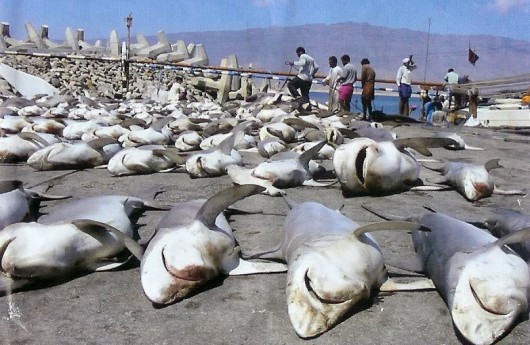 [Source: ^http://www.zmescience.com/ecology/americans-shark-finning-09082012/] [Source: ^http://www.zmescience.com/ecology/americans-shark-finning-09082012/]
.
<<Government representatives to CITES, have agreed to put the porbeagle, oceanic whitetip, three kinds of hammerhead shark and two kinds of manta ray on its Appendix II list, which places restrictions on fishing but still allows limited trade.
Joyce says “conservation groups have been trying for years to curtail the widespread killing of sharks for their meat and for shark fin soup.”
According to The Independent newspaper, scientists estimate that almost 100 million sharks are caught each year, and because they are slow-growing and slow to reproduce, they are especially vulnerable to overfishing.
“Although some regions, including the European Union, have banned shark finning, commercial fishing for fins, meat, liver oil, cartilage and other body parts is largely unregulated in much of the world, conservationists warn. Some countries have been reluctant to include marine species, which can generate large revenues, in the treaty that regulates or bans international trade in wildlife.
The shark fin business is worth an estimated $475 million a year.”>>
.
[Source: ‘International Convention Moves To Limit Shark ‘Finning’ Trade’, 20130311, by Scott Neuman, NPR, ^http://www.npr.org/blogs/thetwo-way/2013/03/11/174018120/international-convention-moves-to-limit-shark-finning-trade]
.
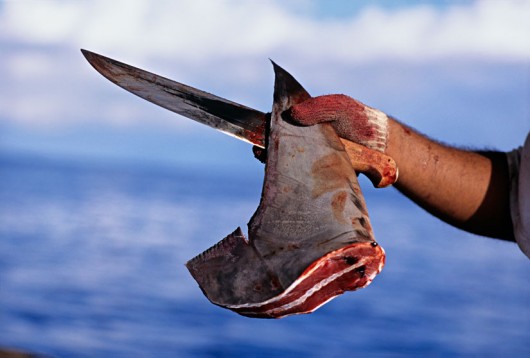 Shark Fin hacked off a live shark
so that backward Chinese can drink superstitious soup Shark Fin hacked off a live shark
so that backward Chinese can drink superstitious soup
.
Further Reading:
.
[1] Stop Shark Finning, ^http://www.stopsharkfinning.net/boycott-australia.htm
.
|
|
 Eastern Water Dragon
(Physignathus lesueurii)
Taken for the benefit of the photograph, not the dragon
Photo by Editor in Blue Mountains, Australia, 20061112, photo © under ^Creative Commons]
Click image to enlarge
Eastern Water Dragon
(Physignathus lesueurii)
Taken for the benefit of the photograph, not the dragon
Photo by Editor in Blue Mountains, Australia, 20061112, photo © under ^Creative Commons]
Click image to enlarge
 [Source: ^http://katialglobal2viceduau.global2.vic.edu.au/personal-learning/]
[Source: ^http://katialglobal2viceduau.global2.vic.edu.au/personal-learning/]
 Not for the camera, but naturally obscured in its habitat
A more interpretative photo, but still too close.
Photo by Editor 20061112, photo © under ^Creative Commons]
Not for the camera, but naturally obscured in its habitat
A more interpretative photo, but still too close.
Photo by Editor 20061112, photo © under ^Creative Commons]
 Badger Den
This mother and young badger were photographed across the road from their den using a 600mm telephoto lens and a 2X multiplier
Photo © Jim Robertson
^http://www.wildwatch.org/Binocular/bino01/empathy.html]
Badger Den
This mother and young badger were photographed across the road from their den using a 600mm telephoto lens and a 2X multiplier
Photo © Jim Robertson
^http://www.wildwatch.org/Binocular/bino01/empathy.html]
 Bull Elk
This bull elk was photographed from my vehicle in Jasper National Park, Alberta, using a telephoto lens
Photo © Jim Robertson, ^http://www.wildwatch.org/Binocular/bino01/empathy.html]
Bull Elk
This bull elk was photographed from my vehicle in Jasper National Park, Alberta, using a telephoto lens
Photo © Jim Robertson, ^http://www.wildwatch.org/Binocular/bino01/empathy.html]
 Grizzly Bear
Grizzly Bear














 Conservation Hunting
Conservation Hunting




















 An example of a purpose-built Wombat Gate
If one can afford property at exclusive Mount Wilson with average prices currently $750,000 [^
An example of a purpose-built Wombat Gate
If one can afford property at exclusive Mount Wilson with average prices currently $750,000 [^































































